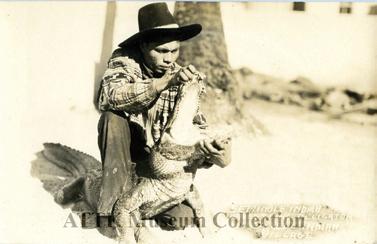
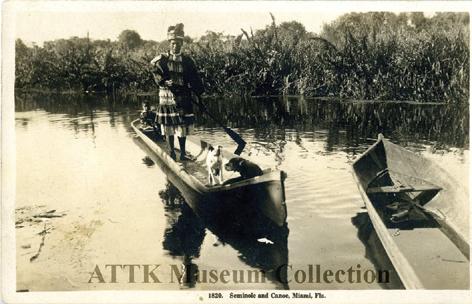
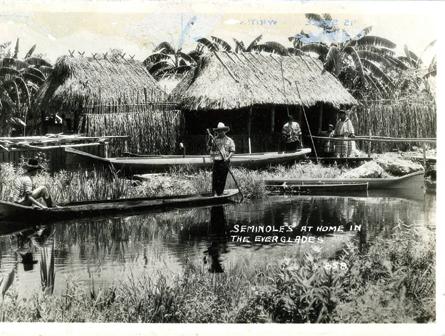
CULTURAL HERITAGE OF FLORIDA
Seminole Alligator
Wrestling: Danger, Entertainment and Tradition
Cattle Ranchers
Florida's Original Conservationists
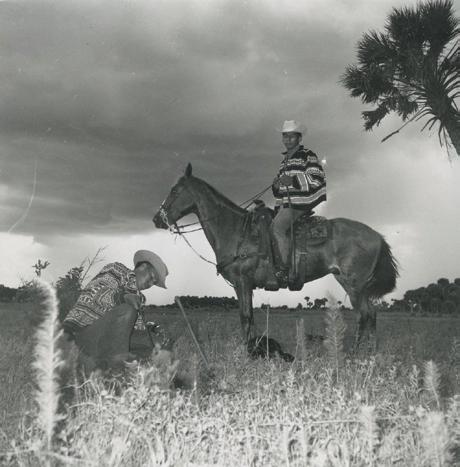
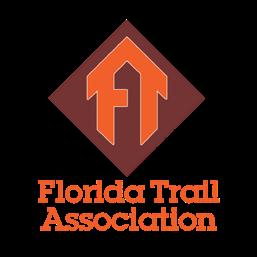
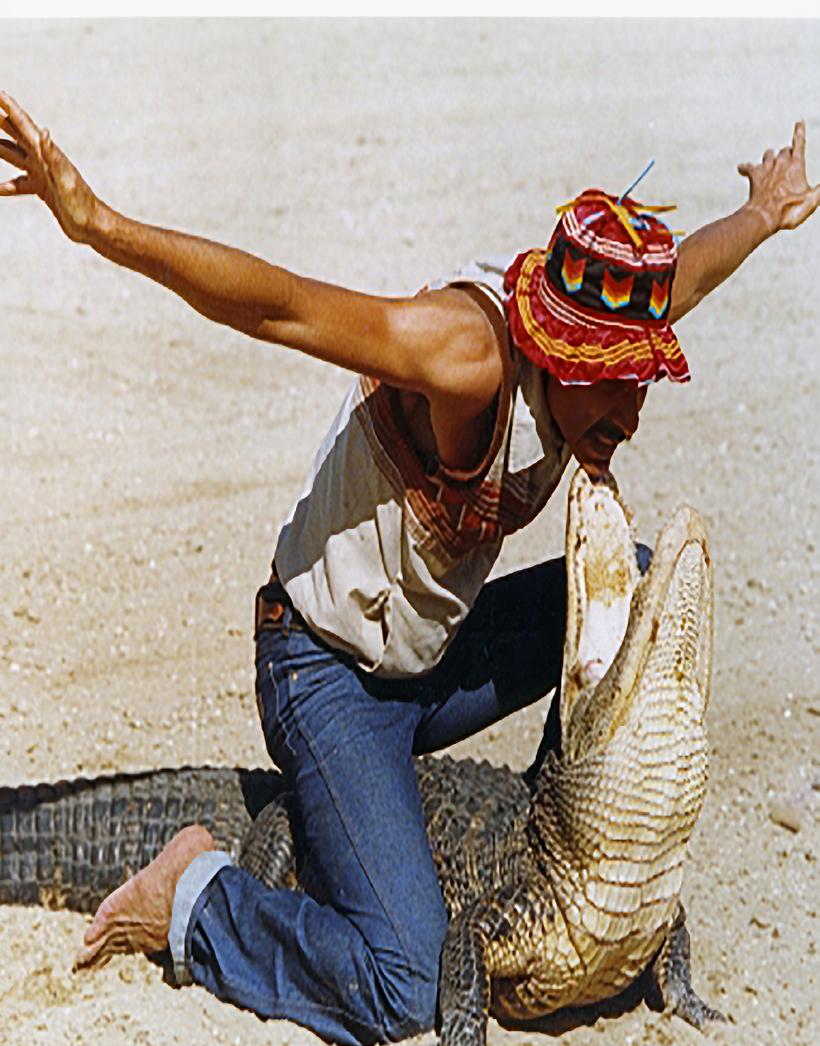

FOOTPRINT
Magazine Spring 2024 Volume 40 Issue 1
SAYING GOODBYE AND THANK YOU: DIANE 'DIDO' STRONG

In support of Florida’s vibrant outdoor community, since 2014 the co-op has been able to contribute over $100,000 to stewarding the Florida Trail and other natural spaces around the state.
Come by and see us at your local REI before heading out to enjoy the fresh air, or visit online at REI.com.
2 FloridaTrail.org Florida Trail Association AD23992315
you
it.
Love it like
built
Because you did.
BOCA RATON — GAINESVILLE — JACKSONVILLE — PALM BEACH GARDENS SARASOTA — TALLAHASSEE — TAMPA — WINTER PARK — REI.COM AD23992315

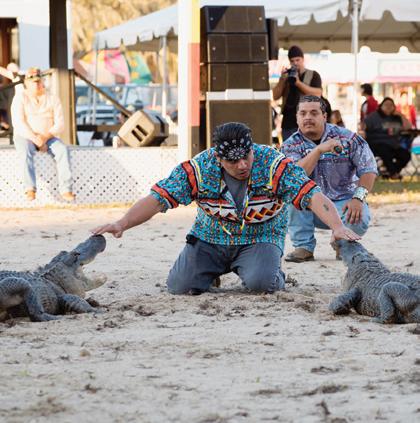
Our Mission
The Florida Trail Association develops, maintains, protects and promotes the Florida National Scenic Trail, better known simply as the Florida Trail. With the Forest Service as our primary partner and administrator, we provide opportunities for the public to hike, engage in outdoor recreation, participate in environmental education and contribute to meaningful volunteer work. The Footprint Magazine welcomes your comments. The
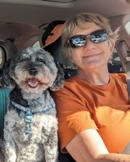

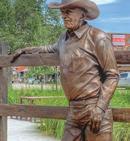
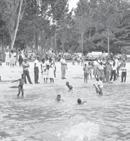
3 Footprint Spring 2024
Contents
objective
received
Letters
be edited for clarity
length. communications@floridatrail.org Footprint Editor Florida Trail Association 1022 NW 2nd St Gainesville, FL 32601
Roots of Resilience, post cards of Seminole life. 26 5 Executive Director's Corner by Royce Gibson 8 Exciting Developments Regarding The Proposed Yellow River Bridge by Adam Fryska 11 Diane: The Trailblazer Behind The Desk by Abe Christian and the FTA Staff 18 A Hiding Place for Indians: The Everglades as Seen Through A Museum's Collection by Tara Backhouse 21 People and Place: A Celebreation of Big Cypress National Preserve by Annie Kilby 26 Seminole Alligator Wrestling Danger, Entertainment and Tradition! by James Patrick 32 Cattle Ranchers: Florida's Original Conservationists by Jenna Taylor 40 The Legacy of Segregation Echoes Through Florida's Landscapes by Jeff Glenn 44 Native American History Along The Florida Trail: Exploring the Byrd Hammock Archeological Site by Catherine Selin 11 18 32 40
editors are committed to providing balanced and
perspectives. Not all letters
may be published.
may
or
Cover Images

About Us
FLORIDA TRAIL ASSOCIATION
1022 NW 2nd Street
Gainesville, FL 32601
Toll-Free: 877-HIKE-FLA
Tel: 352-378-8823
Email: fta@floridatrail.org
Website: FloridaTrail.org
Facebook.com/FloridaTrailAssociation
Digital Magazine: Issuu.com/FlaTrail
BOARD OF DIRECTORS
Chair: Bill Turman
Vice Chair: Maria Llorens
Treasurer: Elwood McElhaney
Secretary: Chelsey Stevens
Directors: Tiffany Bright •Karl Byars
Tom Daniel • Michelle Duncan
Eric Emery • Josh Johnson • James Powell
Rick Robbins • Leslie Wheeler
FLORIDA TRAIL STAFF
Executive Director:
Royce W. Gibson
Administrative Director:
Janet Akerson
Trail Program Director:
Adam Fryska
Communications and Outreach Manager:
Jane Pollack
Membership and Marketing Manager
Britt Moore
Panhandle Trail Program Manager:
Catherine Selin
North Trail Program Manager:
Jeff Glenn
Central/South Trail Program Manager: Vacant Operations Manager:
Abe Christian
GIS Program Coordinator:
Christina Mallica
Gateway Community Coordinator:
Hailey Dansby
Next Generation Coalition Coordinator: Vacant
FLORIDA TRAIL FOOTPRINT
Managing Editor
Jane Pollack Editorial Team:

National Scenic Trail System

OUR MAGAZINE
The Footprint is published by the Florida Trail Association, a volunteer-based nonprofit organization focused on Florida hiking and trail building. Since 1966, the primary mission of our organization has been the care and protection of the Florida Trail, a 1,500-mile footpath across the Sunshine State - Florida’s own National Scenic Trail.
OUR GOAL
To provide outreach to our readers through informative articles that express appreciation for and conservation of the natural beauty of Florida; to inform our readers of Florida Trail Association efforts; and to provide information on Florida hiking and outdoor recreation opportunities.
CONTRIBUTORS
Please contact the editor at communications@ floridatrail.org to discuss ideas for feature stories prior to submission.
MEMBERSHIP
As a Florida Trail member, you receive a subscription to The Footprint magazine, membership in a local chapter, a local newsletter with local activities, opportunities for outdoor skills training, participation in regional and annual conferences and more. To become a member, you can visit our website, mail in the form on the last page of this magazine, or call 352-378-8823.
ADVERTISING
Reach a highly targeted demographic of Florida outdoor enthusiasts by advertising with us or becoming a regular sponsor. Your advertising dollars directly support production and publication of this magazine and assist the Florida Trail Association in fulfilling its mission. Call 877-HIKE-FLA or email communications@floridatrail.org for more details.

4
Trail Association
FloridaTrail.org Florida
Jane Pollack • Britt Moore Adam Fryska • Royce Gibson Layout: Sean Lucas ©2024 Florida Trail Association
rights reserved. Contributors retain copyright to their work but give the Florida Trail Association permission to use to promote FTA and the Florida Trail. Articles are subject to editing for clarity and space.
reflect
of
Florida Trail
The Footprint (ISSN 1064-0681) is published quarterly by the Florida Trail Association The Footprint is printed with soy-based inks on paper with post-consumer content
All
Materials will be returned if accompanied by a self-addressed stamped envelope. Opinions, observations, and endorsements made within the Florida Trail Footprint do not necessarily
those of the board or staff
the
Association.
Postmaster: Send change-of-address form 3597 to: Footprint, 1022 NW 2nd Street, Gainesville, FL 32601
1022 NW 2nd Street Bulk rate postage paid at Pontiac, IL.
Magazine of the Florida Trail Association
The
by Royce Gibson, Executive Director

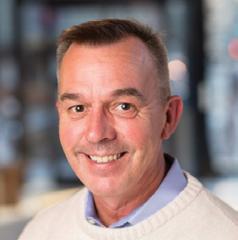
Protecting and preserving a National Scenic Trail is more than just the land and landscape. It is also about protecting and preserving the culture and history of the land. In this issue we look at just a few of the many stories of Florida’s past and present. Hopefully, these stories will inspire you to learn more about your favorite sections of the Florida National Scenic Trail.
Later in this issue we celebrate a huge win in our efforts to close the gaps along the Florida Trail. For decades we have struggled to close a 20-mile gap in Okaloosa County and build a bridge over the Yellow River.
Thank you, Commissioner Nathan Boyles, for leading your county’s efforts
to provide the necessary funding to begin the initial work of designing and planning for the bridge. Thanks also to all the county commissioners and the Okaloosa County Tourism Development Council members who supported the project. In addition to the funds appropriated by the county, the county commissioners also put in another $1.5 million dollar request to the state to build the bridge. This line item didn't make it into the final budget submitted to the governor, but we will ask again next year.
What happened in Okaloosa County can be duplicated in other counties across the state where we have gaps in the trail. Look at the map on the next page and see if you can help connect us with the next trail champion county commissioner. Together over the next year we can turn a lot of the red on the map to orange.
I used the map and ones focused on individual congressional districts during our recent advocacy week in Washington, DC. Trail Programs Director, Adam Fryska, two members of our Next Generation Coalition and I were able to meet with the staff members of about half of our congressional delegation to advocate for FY 2024 and FY 2025 funding for our trail and others. All members of the Florida delegation received a package of materials showing the work we have accomplished over the last year and detailing the needs for the coming year.

Finally, the new year brought a couple of staff changes. Diane Strong retired after 10 years with us. We all miss her in the office. We pay tribute to Diane later in this issue.
Jenna Taylor, our Central/South Region Trail Program Manager has taken a position with the Forest Service and is now the Deputy Administrator for the Florida National Scenic Trail. I’m very glad we will continue to work together and wish her well in her new position.
Have a great Spring,


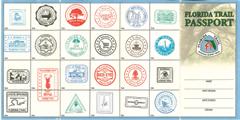
5 Footprint Spring 2024 Executive Director's Corner
Get Your Florida Trail Passport VISIT OUR WEBSITE FOR DETAILS FLORIDATRAIL.ORG
0 6 0 1 2 0 3 0 M i l e s

F l o r i d a T r a i lU S H o u s e o f R e p r e s e n t a t i v e s ( A l l D i s t r i c t s )
6 FloridaTrail.org Florida Trail Association ^ ^_ _ ^ _ ^ _ ^ _ ^ _ ^ _ ^ _ ^ _ ^ _ ^ _ ^ _ ^ _ ^ _ ^ _ ^ _ ^ _ G e o r g i a A l a b a m a D 2 D 3 D 1 8 D 6 D 1 D 9 D 4 D 2 0 D 2 6 D 8 D 2 8 D 1 1 D 1 2 D 7 D 2 1 D 1 6 D 5 D 1 5 D 1 7 D 1 9 D 1 0 2 2 D 1 3 D 1 4 2 5 2 3 2 7 O M W P o k C o l l e r L a k e M a r o n L e v y B a y L e e P a m B e a c h O s c e o a V o l u s a T a y o W a t o n M a mD a d e B r e v a d H e n d r y D u v a l C l a y D x i e L e o n B r o w a r d G l a d e s G u f O a n g e M o n r o e P a s c o L b e r y A a c h u a J a c k s o n P u n a m H i g h l a n d s O k a o o s a B a k e r S a n a R o s a C t u s M a n a t e e N a s s a u H a r d e e D e S o o C o u m b a M a d s o n H i s b o o u g h W a k u l l a S u m e r C h a r o t t e E s c a m b a F a g e r S J o h n s O k e e c h o b e e S L u c e C a h o u n S a r a s o a S u w a n n e e F r a n k l n H o m e s J e f e r s o n L a f a y e t t e G a d s d e n H a m l t o n W a s h n g o n H e r n a n d o n d a n R i v e r U n o n G i l c h r s S e m n o e B r a d f o d P i n e a s S
s : E s r i , H E R E , G a r m i n , U S G S , I n t e r m a p , I N C R E M E N T
N
, E s r i J a
( H o
L e g e n d U S C o n g r e s s o n a D i s t r i c t s F l o r i d a N a t i o n a l S c e n i c T r a i l T r a i l S t a t u s F o r i d a T r a l R o a d w a k C o n s e r v a t i o n L a n d s ^ _ G a t e w a y C o m m u n t i e s
.
o u r c e
,P
R C a n
p a n ,
n g K o n g ) , E s r i K o r e a , E s r i ( T h a i l a n d ) , N G C C , ( c ) O p e n S t r e e t M a p c o n t r i b u t o r s , a n C o m m u n i t y









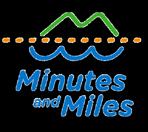

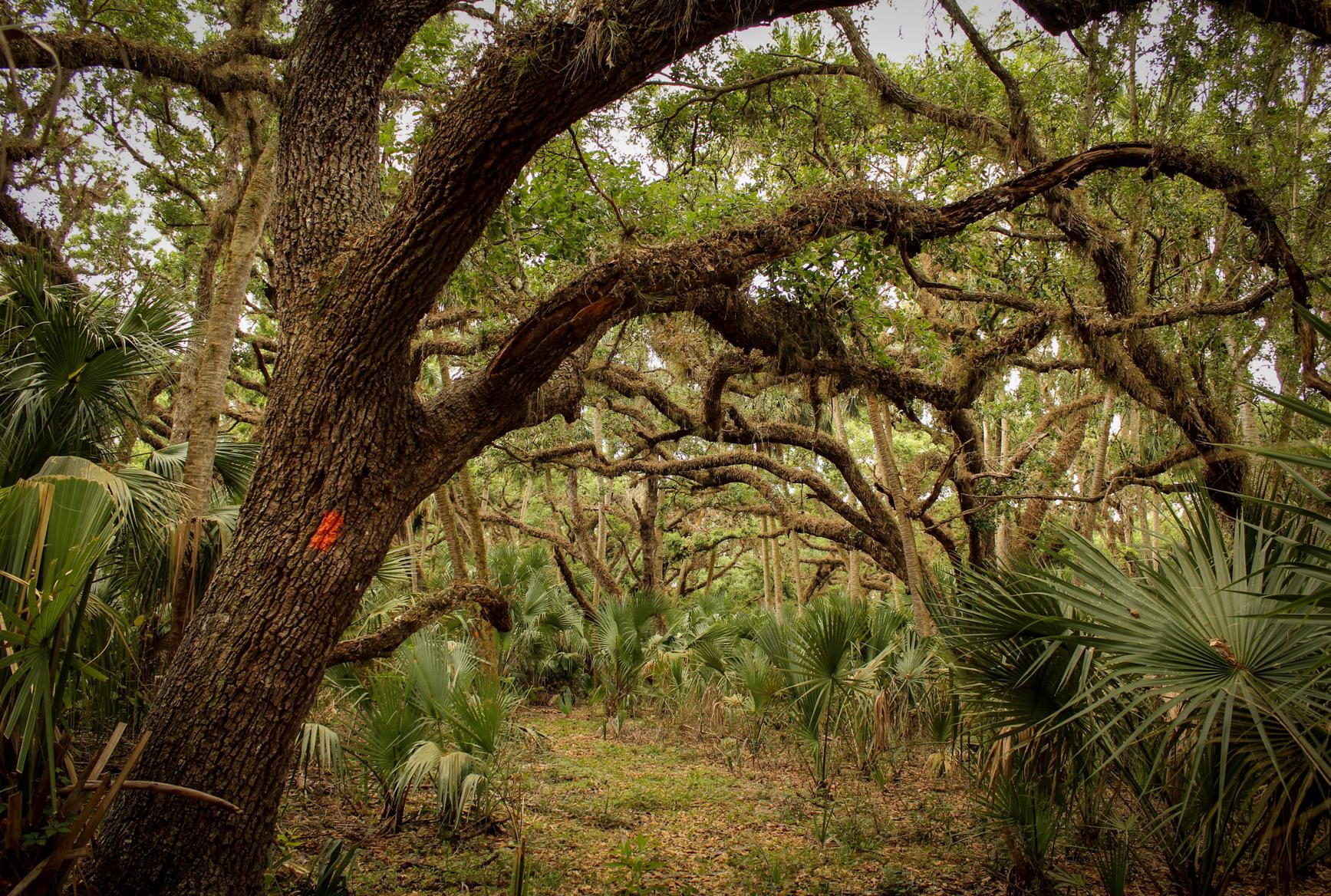

Special thanks to our sponsors: Construction Service Co. of Florida, Inc. IDIDAHIKE 2024
Exciting Developments Regarding The Proposed Yellow River Bridge
by Adam Fryska, Trail Program Director
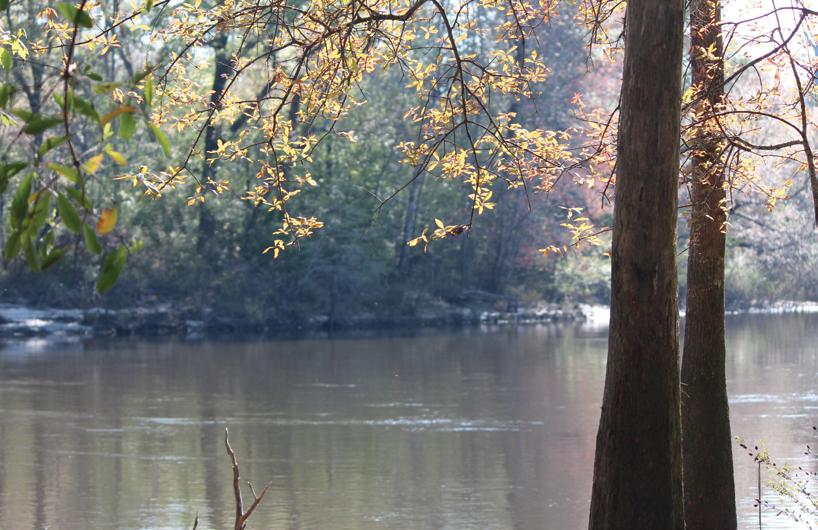
The past couple of months have seen several major developments regarding a proposed footbridge for the Florida Trail across the Yellow River in Okaloosa County. In late December, the Okaloosa County Tourism Development Council voted to recommend allocating $1 million in tourism development tax revenue towards initial project planning, permitting, and design for the bridge. A large contingent of FTA volunteers and board members turned out at the TDC meeting to express support for this recommendation, focusing on the recreational and economic value the Florida Trail brings to the community for both local residents and visitors. Early in January the Okaloosa County Board of County Commissioners followed through on that recommendation, voting to commit $1 million towards the project. This unprecedented local investment in the Florida Trail is a momentous occasion for the trail and another important step along the long journey to close our remaining trail gaps.
The Yellow River Bridge will be the grand culmination of over 30 years of work to develop a continuous footpath for the FT in the western Florida panhandle. These efforts include the groundbreaking agreements with
Eglin Air Force Base that permitted trail routing through an active military installation, as well as more recent work to link together scenic wetlands along the Yellow River that are administered by Blackwater River State Forest and the Northwest Florida Water Management District (NWFWMD). For now, these two trail segments are separated by a 21 mile highway roadwalk, leading hikers through Crestview and along the busy shoulders of US90 and SR85. This roadwalk is one of the FT's longest remaining gaps, and a solution has appeared tantalizingly close; building a bridge across the Yellow River, linking existing trail in Eglin Air Force Base to new trail construction on the river's western banks.
Once complete, this bridge will be by far the longest along the Florida Trail, and among the largest and most prominent bridges in the entire National Scenic Trail system. It will span several hundred feet across the river below, at a height that ensures river traffic is unimpeded. Together with our partners, we envision a bridge that will serve as a regional destination, leading to an entirely new segment of the Florida Trail, complete with trailheads, boardwalks, interpretive displays, and access to public lands along the beautiful Yellow River. It will be a major part of future
tourism development initiatives in northern Okaloosa County. Achieving this vision will now require close collaboration between our entire team of partners, including Okaloosa County, the USFS FNST Administrator, Eglin Air Force Base, and NWFWMD. FTA wishes to express great appreciation and thanks to the Okaloosa County Tourism Development Council, the Okaloosa County Board of County Commissioners, and Okaloosa County staff for their vote of confidence in this project and the Florida Trail as a whole. We'd also like to particularly highlight the strong support of Commissioner Nathan Boyles, who has championed and advocated for this bridge throughout the entire process. This initial funding will allow the County to work with partners on the important early steps of project planning and bridge design. Efforts are continuing across multiple fronts to secure additional funding for the bridge construction. There's much hard work ahead, but the payoff will be tremendous; a completed bridge and trail segment that will guarantee access to the Yellow River's unique natural and scenic beauty for future generations. We’re confident this project can be completed, and we’re excited to keep working with our partners to make it happen.
8 FloridaTrail.org Florida Trail Association
The Yellow River.
Photos courtesy of Wallis Mayo


9 Footprint Spring 2024
Photos courtesy of Adam Fryska
Turkey Hen Creek marks the start of the Cimarron Section.
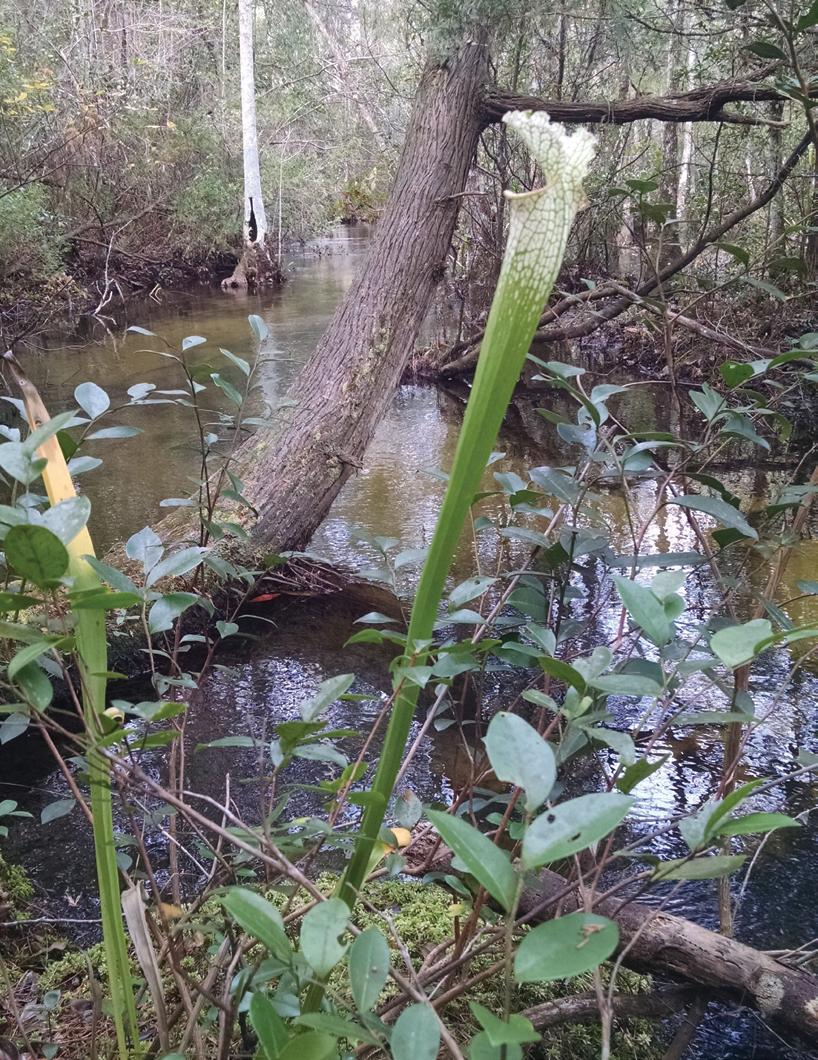 Pitcher plants are often found in the scenic Yellow River Ravine wetlands.
Pitcher plants are often found in the scenic Yellow River Ravine wetlands.
10 FloridaTrail.org Florida
Association
Photos courtesy of Debbie Chadwell
Trail
Diane: The Trailblazer Behind the Desk
by Abe Christian and the FTA Staff
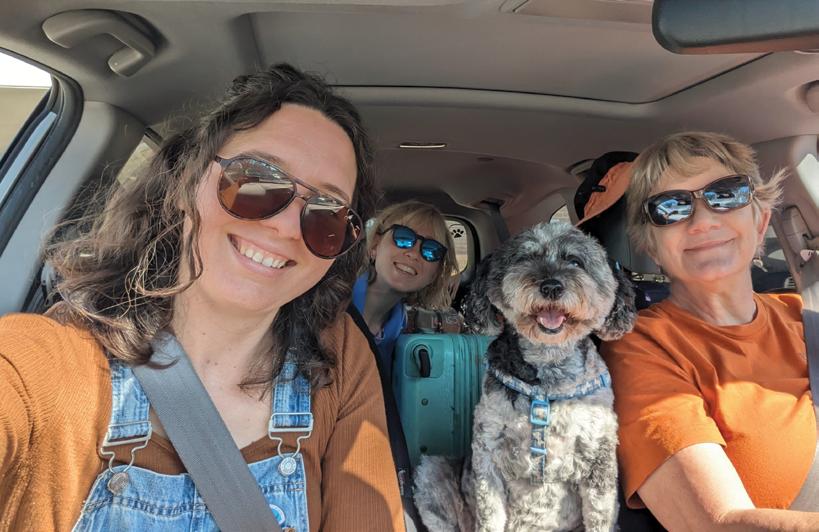
There's a saying that goes, "Some heroes wear capes, others wear name tags." In the case of Diane "Dido" Strong, who recently retired from the Florida Trail Association after over ten years of service, both statements hold true. While Diane might not have donned a cape, she was undoubtedly a hero for the organization, tirelessly serving as the welcoming face (and voice) that greeted volunteers, hikers, and members alike.
“
If I could describe Diane with one word....it would be "fun". Everytime I went into the office, she was jovial, engaging.... and fun. She has a unique perspective and makes the most boring tasks...fun!
Too bad, she retired....but time marches on!”
~Rick Robbins, Board of Directors and Sandhill Chair
Diane's role with the FTA went far beyond answering phones and manning the front desk. She was the glue that held many crucial operations together. She meticulously managed the membership and activity leader databases, ensuring everyone was connected and informed. She played a vital role in welcoming and celebrating thru-hikers, awarding them their end-to-end certificates and patches, a tangible reward for their incredible accomplishment. Whether by phone, email, or in person, Diane was the ever-helpful problem-solver, ready to answer questions, direct callers, and connect them with the right resources.
“
But Diane's impact extended far beyond her official duties. Her genuine warmth, infectious smile, and friendly demeanor made her the heart and soul of the FTA office. She possesses a keen sense of humor, a profound understanding of all things FTA, and of shipping and packaging, ensuring every item reached its destination safely and promptly. Dido managed the online shop with efficiency and care, providing excellent customer service and resolving issues with ease.
For some, like myself, Diane wasn't just a colleague; she was a mentor. She patiently passed on her knowledge and expertise, offering mini-training sessions over the years.
“I remember properly meeting her for the first time at the staff holiday party in 2022. There were still a bunch of new faces and those I did know I had only met a few times before. Diane was so warm and kind and immediately made me feel very welcomed. Those pre-party jitters melted away and I felt so much more at ease just because of how sweet and caring Diane was. I wish I got to see her more often but I appreciate the times I had with her and hope for the best for her in the future.”
~Catherine Selin, Panhandle Regional Trail Program Managers
11 Footprint Spring 2024

“ People will forget what you said, people will forget what you did, but people will never forget how you made them feel.”
~ Maya Angelou
I can’t think of a better quote to conjure the essence of Diane Strong. In my short tenure at FTA, each day of office work has been brightened by Diane’s cheeriness and authenticity. She is eternally generous with her knowledge, from helping me decipher the copier to speaking the language of Donor Perfect to explaining to me again and again the most economical way to ship a package. This wisdom is often livened by stories from her youth and pop culture references contemporary to her.
Diane truly listens to people. Each day from my office I can hear her on the phone with FTA members asking after pets and children by name, checking in after medical procedures, recalling the last time she spoke with the voice on the other end of the line. She asks because she wants to know and when she works with others her work is infused with immense care.
Diane also knows how to celebrate. She can take a rainy, sleepy summer Friday afternoon at the office into something exciting with a simple “let’s order Gyros Plus for lunch!” Or a “MAIL’S HERE!”. Diane is probably the only person who could get me excited about coming to the office on a Sunday morning to help her stuff envelopes.
When I work with volunteers or partners within the FT community I hope to harness the lively enthusiasm and generous care that Diane brought to her work every single day. How lucky we are to have her in our community!
~Hailey Dansby, Gateway Community Coordinator

12 FloridaTrail.org Florida Trail Association
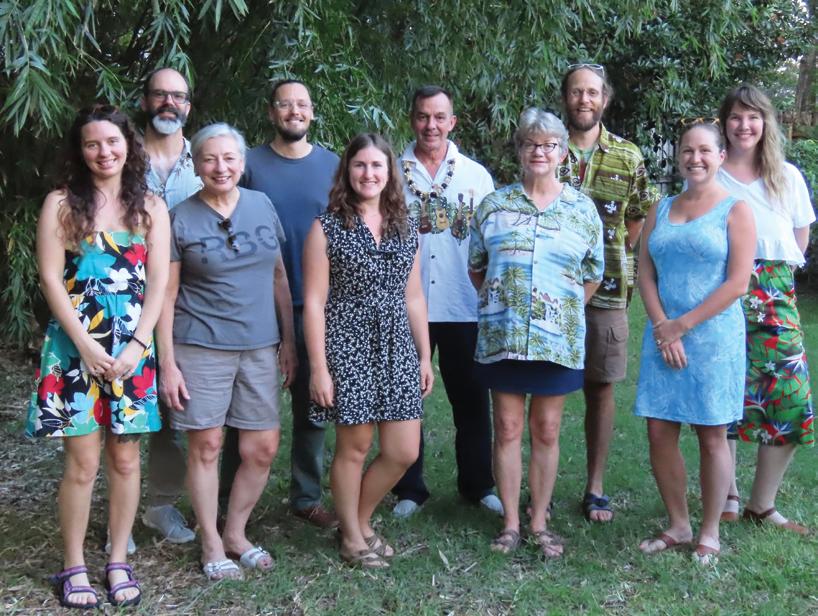
When she went on vacation, I had the privilege of covering for her, gaining firsthand experience and valuable insights. Diane's mentorship fueled my passion for the FTA and my commitment to its mission.
Diane's decision to retire is bittersweet. While we celebrate her well-deserved freedom and wish her all the happiness in the world, there's no denying the void she leaves. However, her legacy lives on in the smooth-running operations she established, the countless individuals she helped, and the warm memories she leaves behind. Diane may not have craved recognition, but it's important to acknowledge the immense contribution she made to the FTA. She was, and always will be, a true trailblazer, making the path smoother and brighter for everyone who followed.
“
Diane is already greatly missed at the office. She never talked to a stranger and the place seems deserted without her. It was a great pleasure to work with her over the last few years.”
~Royce Gibson, FTA Executive Director
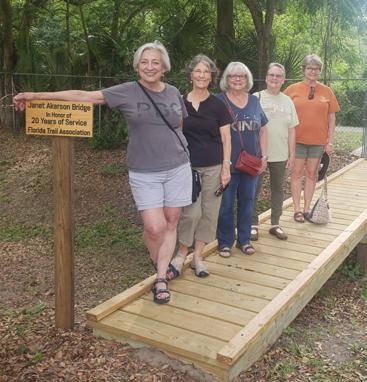
13 Footprint Spring 2024
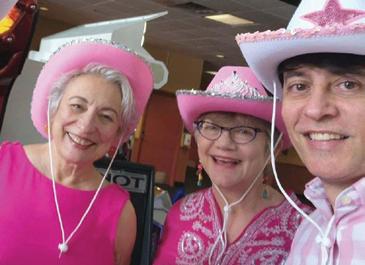
“
Diane came to FTA in the spring of 2013. I promptly made her cry.
I cannot imagine what the last 10 years of my life would have been like without Dido. She is my FTA soulmate and I, along with everyone else, love her. This isn’t hyperbole. Delivery drivers, the membership, servers in restaurants, our vendors, equipment repair people, her co-workers, dogs (especially her Jesse), cats and rats- all love Dido.
It was impossible to see her in the morning and not smile. Each morning at FTA began with the two of us sitting on the floor in her office, brushing Penny, the world’s most well-groomed “kittn.” The conversation always revolved around the politics of the previous day and food. “Can you believe that happened and where are we going for lunch?” Trump, Biden, burritos, fajitas, bento boxes, Falafel King, and Fridays at Paisano’s. Girls’ night at my house with prime rib and maybe too much wine, laughing until it hurt. The Monday farmers’ market just down the path from the office for veg and tunes and great chats. And the best toast ever for office breakfast. A lot of fun emanated from “our” three FTA offices.
Dido is one of the most genuine people I know. She cares deeply about people and the world around her. She’s well read and smart and resourceful. She knows history. She’s an environmentalist. She’s kind and never petty. She made that front desk position hers. She is missed and I’m so grateful for the time she spent with us. She is, undeniably, a gem.
~Janet Akerson, Administrative Director

“
The minute I met Diane, it felt like I was instantly part of the Florida Trail family. She had this laid-back vibe that just lit up the office every single day. Even though I only had a few months to work alongside her before she retired, I'm so glad I got to know her. She's the embodiment of the caring spirit that makes the Florida Trail Association so special.”
~Britt Moore, Membership and Marketing Manager
14 FloridaTrail.org Florida Trail Association
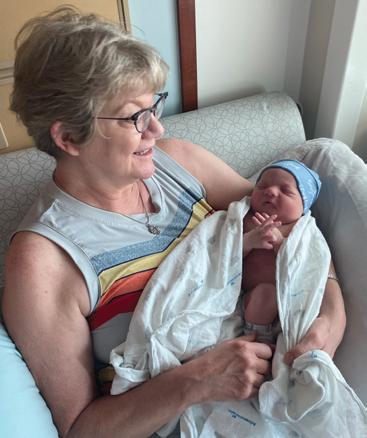
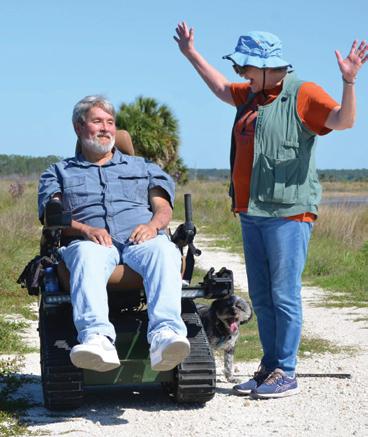
Comments from her personnel file:
“Thank you for your kind and thoughtful reply. I would like to maintain my membership.” -GE “Thank you. I know it’s your job but you do soooo much for us and we sincerely appreciate it.” -RM “Thanks for helping me turn lemons into lemonade today. You have no idea how much your friendly voice and enthusiasm and passion for FTA helped to brighten my day.” -PS
“Congratulations on your retirement! You accommodated my endless last-minute requests for information and always knew exactly what was going on.” -CS
“
Diane, thy middle name must be "willing" or "cheerful." No matter how often I called you on knotty matters, whether related to memberships or other FTA issues when I wasn't sure who else to call, you were always upbeat and willing to take care of the issue or get me to the right person and you always left me laughing. You were a "feel-good" tonic! You and Janet have worked together as a marvelous team and kept the office functional during some rocky years. You both earned kudos and words of appreciation for that. Best wishes for a fabulous retirement. You've earned it.”
~Helen Wigersma, Treasurer Western Gate
“
Over the past ten years, as a chapter chair and board member I have had quite a bit of interaction with Diane. Diane was always there with a smile and witty comment, very helpful whether purchasing merchandise, getting membership information, signing up for state outings, discussing awards, or having a beer. Diane has been a credit to the Florida Trail Association, and will be sorely missed. I wish her success and happiness in the future, and hopefully her dreams can come true.
~Bill Turman, Board of Directors Chair and Central Florida Chapter Chair
15 Footprint Spring 2024

“
Diane started six months before I did at the FTA so I was lucky to spend nearly 10 years with her here. No offense to anyone else at the FTA, but, hands down, Diane was my favorite co-worker of all time, at any job I've ever had! I'm not sure I've ever been around someone who laughed and smiled as much as Diane does. Everyone that called or walked through our doors instantly was welcomed and appreciated and she just had this way of connecting and being so free with everyone. Beyond the FTA, Diane is a close friend and I'm so thankful for that, because I miss working with her.
~Jeff Glenn, Senior Regional Trail Program Manager and Field Project Manager
“
From the minute I started working with the FTA team, I felt like I had known Diane for 20 years. I walked into the room and she jumped up to hug and welcome me to the FTA. She is one of the warmest, most welcoming people I have ever had the pleasure of being around. Her warmth, sense of humor and candor brought levity and joy to the FTA community."
~Jenna Taylor, Central South Regional Trail Program Manager
“
Diane radiates love and kindness. She made the FTA office feel like home with her daily rituals of taking care of furry friends and announcing “Mail’s here!”
I remember purchasing maps from her before I started working for FTA and she answered all my questions, as she always did with folks who needed help. She openly shared her knowledge about all things Florida Trail and connected countless individuals with the FTA community.
She always seemed to have the answers. At work, she used her positive attitude to get through sticky situations. In personal matters, she proffered the sage advice of a mother (she was our Florida Trail mom, afterall).
I admire her candor, free-spirited nature, and kindheartedness. Whenever I got wrapped up in the chaos of work and life, I could always count on Diane to make me smile and remind me to not take things too seriously. I miss her sweet presence at the office, but I’m sure I will see her on the trail or at a local event enjoying her freedom!
~Jane Pollack, Communications and Outreach Manager
16 FloridaTrail.org Florida Trail Association
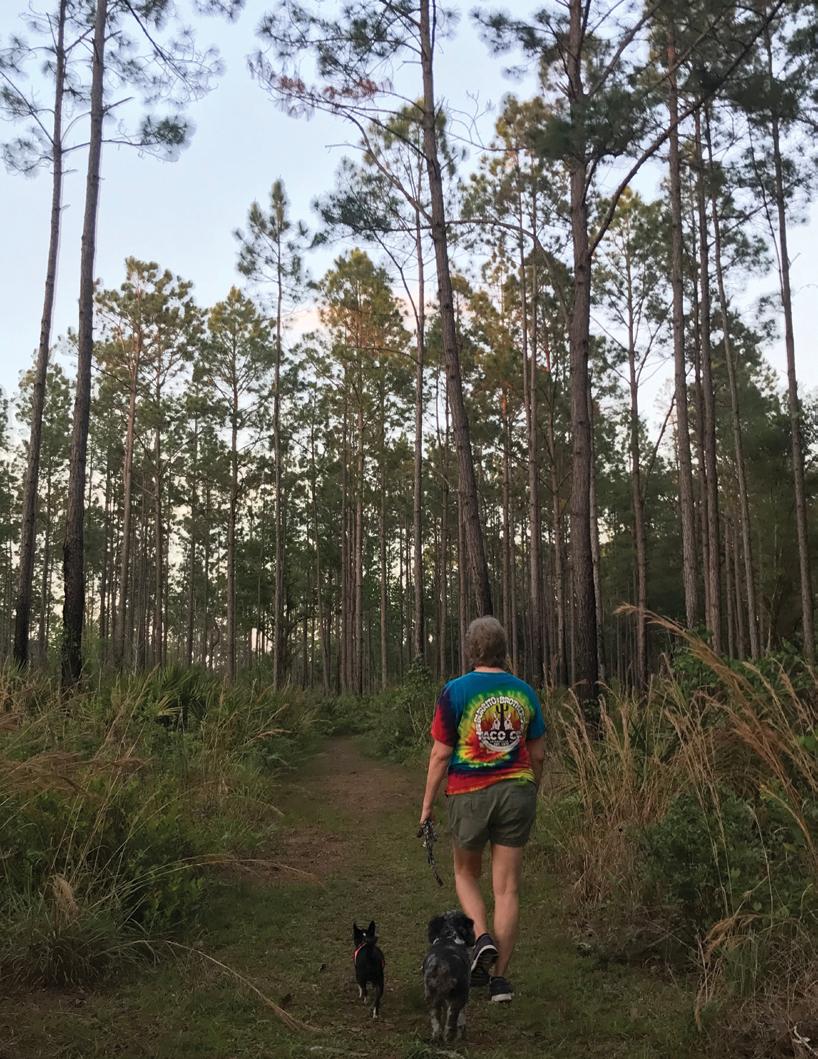
Footprint Spring 2024

“A Hiding Place for Indians”
by Tara Backhouse, Curator at the Ah-Tah-Thi-Ki Museum
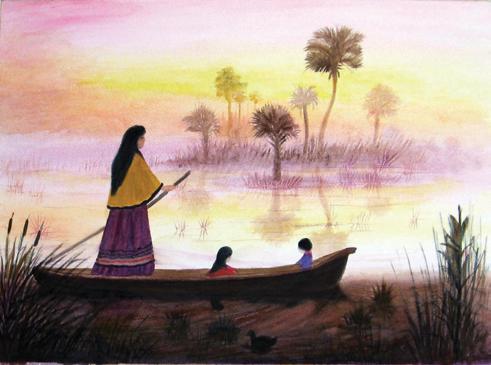
The Everglades as Seen Through a Museum’s Collection
When you experience a landscape, whether by foot or by vehicle, you see a glimpse of its past. For example, when it comes to the Everglades, the canals you pass show evidence of largescale water management. But you rarely see the past clearly, or the effect that the environmental changes have had on the people around you. Both long and short-term changes in our environment can have a big impact on both visitors and residents. So how can we learn more about the changing Everglades and stories of the people who have traveled through it and who call it home? Some of these stories can be told through the historic collection of the Ah-Tah-ThiKi Museum. Consisting of approximately 240,000 objects the collection tells many stories, one of which is the story of the changing environment and its effect on the indigenous people of south Florida.
The Museum’s collection holds many unique Seminole art pieces as well as historic and modern archival items that were not cre-
ated by indigenous people. Both kinds of objects chart the history of the Everglades and the thought processes of those involved in its use and management. For example, thousands of historic newspapers that span the 19th and 20th centuries are good examples of how non-Seminole sources can tell the Seminole story. The 19th century issues report news of the Seminole Wars, which really seemed like one big war to the indigenous population. They boldly cite Florida’s environment as a military problem, as the ever-present water and dense vegetation kept Seminoles hidden and hindered the movement of U.S. Troops. One example is a National Intelligencer from September 28th, 1836; Vol. 37; No. 5363 (ATTK Catalog No. 1995.8.8).
Indigenous viewpoints were rarely published in the 1800’s. However, newer 20th century newspapers reveal both Seminole and non-Seminole viewpoints. In an article in Fort Lauderdale News from January 28, 1964 (ATTK Catalog No. 2005.1.215) the Miccosukee Tribe rails against a noteworthy
(Photo 1) An untitled watercolor
Osceola is a beautiful rendering of a traditional Seminole landscape ( ATTK Catalog No. 1995.67.3 ).
government road project in 1964. Earlier than that, in a newspaper clipping from the Miami Herald on July 28, 1957 (ATTK Catalog No. 2005.1.505), non-Tribal sportsmen protest indigenous control of land and water that they want to be freely open to all. In contrast, an amazing letter to the editor from Ernie Bert, published in a 1985 issue of the Seminole Tribune (ATTK Catalog No. 2015.44.80) reveals an impactful Seminole opinion. Ernie passionately writes about the draining of the Everglades, bemoaning the loss of wildlife that some people use for food, stating "Our clan system, our legends, our medicine are all centered around animals." This implies that Seminole culture cannot endure unless the environment is preserved.
Another type of document, a congressional report, tells a particularly crucial part of the Everglades drainage story (ATTK Catalog No. 2004.1.844). This U.S. Senate report from 1848 details the original reasons and the first act that authorized the drainage of the Everglades. The first and most written about was the financial benefit that could be gained from increased agriculture and settlement in the region if it were drained by canals and controlled by levees. Another reason considered was so that the land could be better used to defend the U.S. from its Cuban enemies. But a third reason is to finally drive indigenous people from their homes in Florida. The article’s title quote “a hiding place for Indians”, was written by J.T. Sprague in 1847. It communicates a colonial viewpoint regarding the Everglades environment. It was seen as a detriment to expansion, and a deadly trap for any non-indigenous visitors. The report notes that “the recent Seminole war drove settlers away. And since the remaining Seminoles aren't likely to leave, the best way to convince them to join their brothers to the west would be to have settlers return to the parts of Florida not set aside for the Indians.” (pg 24) If they don't, he fears that all of Florida will belong to the Seminoles. In this early document, the
18 FloridaTrail.org Florida Trail Association
by Mary Gay
continuation of a military strategy during a supposed time of peace is evident. It is resources like this that provide long-standing context for the feelings of mistrust that are still widespread today when Seminole people deal with the U.S. government on environmental matters.
19th century letters echo the newspapers of the same age. Perhaps this is because much of the information about the Seminole War that made it into the newspapers did so because of letters composed and sent from the field of war. In an 1838 letter, future U.S. President Zachary Taylor instructs Colonel Smith to make it a priority to detail how the Seminole enemies can be reached, either by land or water (ATTK Catalog No. 1999.33.1). Laying this plea alongside the 1848 senate document, the continuity between military strategy and civil engineering projects becomes even clearer.
The work of Seminole artists show feelings and memories that contradict the 19th century colonial view of the Everglades. For example, this watercolor by Mary Gay Osceola (Photo 1) shows a romantic memory of an idyllic Everglades landscape of the early to mid-20th century. The artist is surely not alone in her memory of higher water levels and canoes as the primary mode of transport, as others in her senior age range look back on similar childhood memories fondly. Postcards from the mid-20th century, such as one titled, “Seminoles at Home in the Everglades” hint at the same thing, despite the fact that much swampland drainage had already occurred by the time they were produced (ATTK Catalog No. 2001.34.8). Other postcards show how tourism enterprises became a routine part of many Seminole lives (ATTK Catalog No. 2003.15.106).
Hundreds of photographs in the Museum’s collection that show past and current landscapes as well as Seminole people’s relationship to them. The majority of them date squarely to the middle and later parts of the 20th century. By the time most of these photographs were taken, a majority of drainage and engineering projects were underway and the Everglades was profoundly changed. However, one of the earliest aerial photos in the Museum’s collection shows a camp isolated from roads, intruders and urban development by abundant water and uninhabited land. This was the natural way to live in the Everglades, with a low people to resources ratio. It was sustainable and families could be generous with their supplies and space when others came to visit (Photo 2)
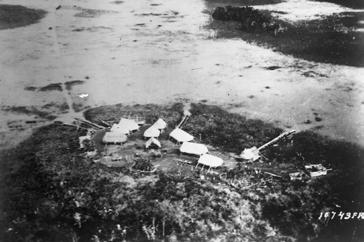
(Photo 2) Early 20th century aerial photograph of a Seminole camp on the Tamiami Trail where Bill Osceola grew up. This photograph appears to have been taken before many of the current water management projects were in place ( ATTK Catalog No. 2009.5.89 ).
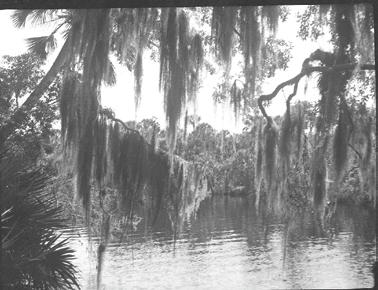
(Photo 3) This beautiful early 20th century watery scene both beckons the viewer and keeps the viewer at bay with its Spanish moss obstruction ( ATTK Catalog No. 2007.46.288 ).
Other early 20th century landscapes are haunting and ethereal (Photo 3). It’s easy to see why non-Seminole visitors had a variety of opinions about the environment, both favorable and not. Some other photographs of early traditional camps are serene scenes with chickees set in the lush Everglades landscape. The first example photo shows an early 20th century camp situated in a sea of grass, clearly prior to any successful drainage projects affecting the area. Similarly, the second photograph shows a rarely seen canoe trail, as a man poles a canoe away from the camp in the background. These two photos are classic examples of the traditional Seminole environment based lifestyle. (Photos 4 and 5, Next Page)
The environmental changes of the early 20th century are evident in many photos. The photographs show some of the changes
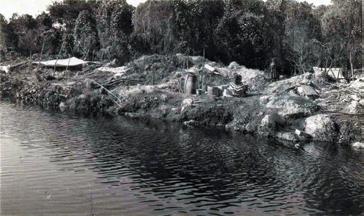
(Photo 6) This image shows a relatively new canal, as evidenced by the spoil piles on the bank that resulted from the digging process. A Seminole family makes use of the area in a temporary camp on the banks ( ATTK Catalog No. 2000.17.1 ).
19 Footprint Spring 2024
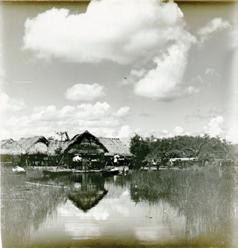
(Photo 4) A view of Little Billy Conapatchie's camp, attributed to photographer Julian Dimock; Billy Conapatchie is also known as Billy Cornpatch. ( ATTK Catalog No. 2012.3.1 ).
that Seminole camps went through during the quickly changing 20th century, when the plentiful water disappeared and surrounding development encroached on Seminole lands. Early pictures of new canals dug to control the Everglades water flow show both the lifestyle and the environmental devastation that came with this engineering work. Camps that were located by canals, whether permanent or temporary, show that Seminole people had to adjust to this new way that water was flowing. Camp locations next to canals were not always ideal, so temporary camps had to be set up amongst dredging soil piles in a denuded landscape (Photo 6). This was so different from life before drainage in a plentiful natural environment.
The next two example photos show camps in a forested and semi-tropical environment, but their dates are decades apart. Both the differences and the similarities in these photos are interesting. They are both secluded by the vegetation. This was no doubt done for practical reasons as well as traditional ones. However, the untamed landscape of the first picture, which dates between 1910 and 1940, contrasts with the fenced and drained pasture in front of the camp in the other picture, which dates to 1967. Drainage and development had clearly increased during the time periods of the two pictures. However, they both show that Seminoles preferred to live secluded in the natural environment whenever possible, for the larger part of the 20th century. (Photos 7 and 8)

(Photo 5) A man poles a dugout canoe along a watery trail leading from Tommy Osceola's second camp, attributed to Julian Dimock. This photograph was taken before Everglades drainage was completed and before roads were constructed in the area ( ATTK Catalog 2012.3.34 ).
So what does the Ah-Tah-Thi-Ki Museum’s collection tell us about the Everglades? Is it, as an 18th century U.S. Army lieutenant noted, a hiding place and impediment to civilization? Or is it a wondrous and beautiful place that provided a safe haven to people that had been driven there by an invasive military force that had been attempting to eradicate and drive them away from their homes for hundreds of years? It could certainly be either, depending on the perspective of the person who experienced the Everglades in its natural state, before the enormous engineering projects that comprised Everglades drainage took place in the late 19th and early 20th century. Either way, constant change and adaptation are overarching themes that run through the Seminole story as told through the Museum’s collection. Whether it is strict environmental description and discussions of resource procurement, or emotional and practical reactions to changing lifestyles, the Museum’s collection tells a rich Seminole story that needs to be part of the stories the Museum tells to visitors and to the Seminole community. As you travel through the Everglades, notice the way that knowledge of the past can enrich your experience. Remember that the landscape holds the stories of thousands of years and of countless people. And as you’re traveling through, stop in to visit the Ah-TahThi-Ki Museum. We’ll see you in person or online!
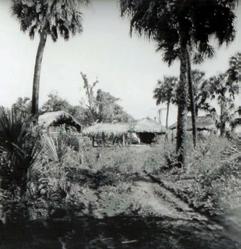
(Photo 7) A footpath leads to a camp surrounded by tall palms and bushy vegetation. The chickees blend into the natural environment beautifully ( ATTK Catalog No. 2007.46.45 ).
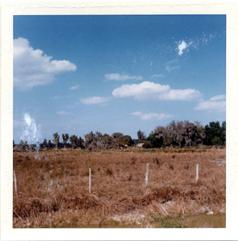
(Photo 8) A Seminole camp can be partially seen amongst the trees in the background, well hidden. Note the fencing and drained landscape in the foreground ( ATTK Catalog No. 2005.27.638 ).
Online Tools
Seminole Tribe of Florida
Ah-Tah-Thi-Ki Museum
About Us (ahtahthiki.com )
You can look up the catalog number listed in this article and see more information using our online collections:
Online Collections
Ah-Tah-Thi-Ki Museum
( pastperfectonline.com )
20 FloridaTrail.org Florida Trail Association
People And Place
by Annie Kilby, Park Ranger at Big Cypress National Preserve
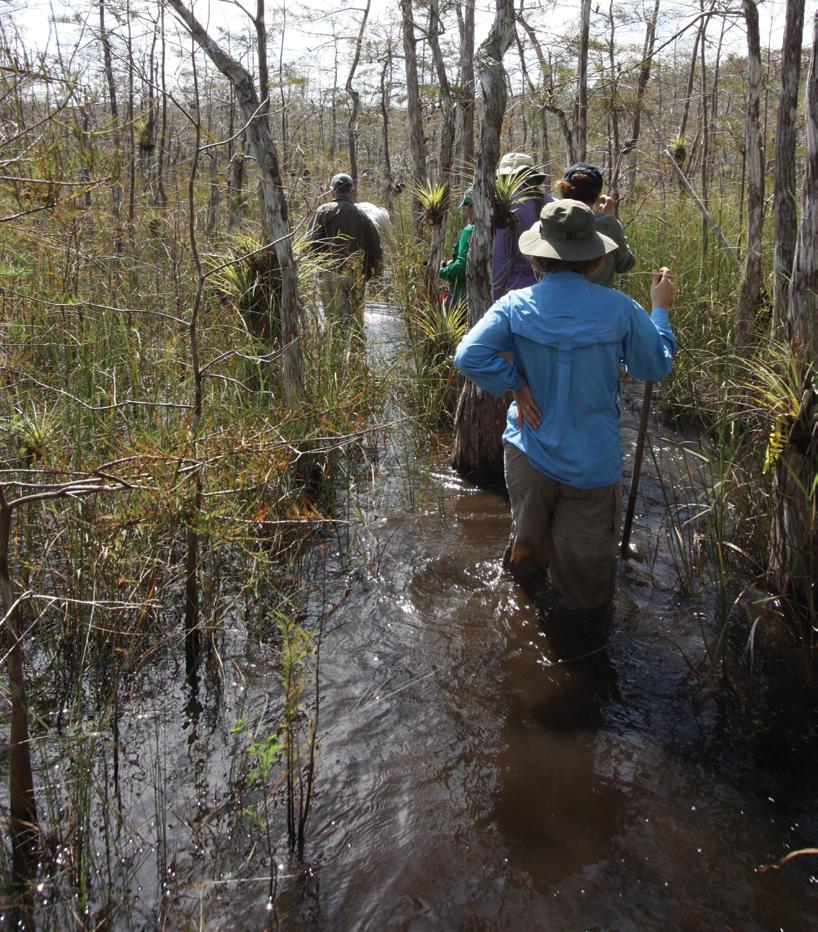
A CELEBRATION OF BIG CYPRESS NATIONALPRESERVE
October 11, 2024, marks the 50th anniversary of Big Cypress National Preserve, one of two preserves established in 1974 and first in the nation. The story of Big Cypress National Preserve is a story of partnerships, of collaboration, and of people who live and recreate within the bounds of the Preserve. It is the stories of these people who have dedicated themselves to this amazing environment for generations that comprise the unique and special history of Big Cypress National Preserve. Without the coalition of people with deep ties and connection to the Big Cypress Swamp, the mosaic of hammocks, pinelands, prairies, cypress swamps and mangrove estuaries would likely no longer exist. Recognizing the need to protect the land, but apprehensive of the limitations of the establishment of a National Park, the concept of a National Preserve was born out of compromise. This new land management concept—a
National Preserve—would protect both the land and the traditional uses of Big Cypress Swamp.
Spurred by increasing growth and a rapidly expanding population of south Florida in the 1960s, plans for the world’s largest jetport were unveiled to be built in the heart of the Big Cypress Swamp. The proposed jetport would have forever changed the landscape of southwest Florida. Alarmed by the threat that the Everglades Jetport posed to the region, a diverse coalition of people, consisting of the Seminole Tribe of Florida and the Miccosukee Tribe of Indians of Florida, Gladesmen, sportsmen and environmentalists set out to protect the Big Cypress Swamp and stop the construction of the jetport.
On October 11, 1974, President Gerald Ford signed legislation creating the nation’s first two national preserves, Big Cypress and Big Thicket, to "assure the preservation, conservation, and protection of the
21 Footprint Spring 2024
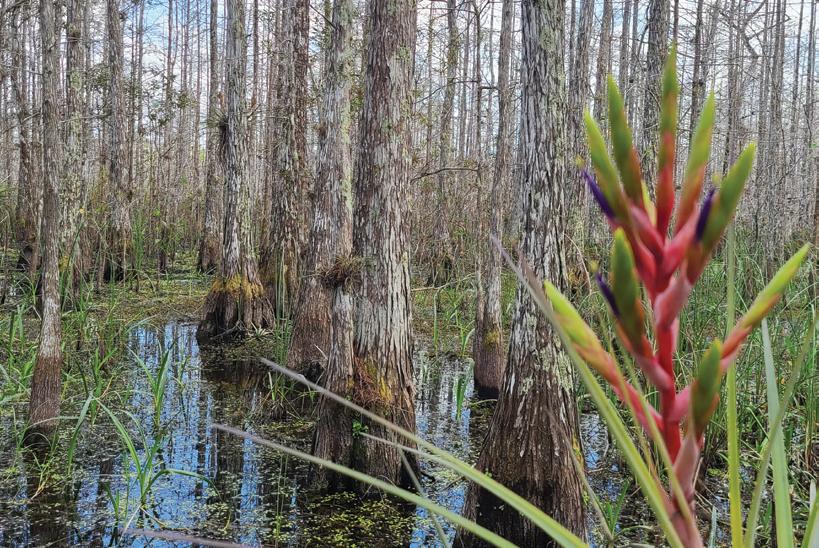
natural, scenic, hydrologic, floral and faunal, and recreational values of the Big Cypress Watershed in the state of Florida and to provide for the enhancement and public safety thereof." At the Preserve’s inception, six areas of traditional uses were protected, and while the preexisting cattle leases have since expired, the other five traditional uses of Big Cypress National Preserve continue today. Those uses include hunting, oil and gas exploration and extraction, operation of off-road vehicles, private land ownership, and the traditional and customary uses of the Seminole and Miccosukee Tribes. On top of protecting these traditional uses, the Preserve seeks to protect and improve the natural conditions within Big Cypress.
For 50 years, the Preserve has worked to protect: a vital watershed and source of drinking water, a diversity landscapes, the habitat for the endangered Florida panther and other animals, a rich and biodiverse habitat for tropical and temperate plants and, perhaps most importantly, the opportunity to visit and experience Big Cypress. As an International Dark Sky Park, Big Cypress also protects one of the darkest skies east of the Mississippi River, and on a clear night, the Milky Way is visible. It is through the hard work of our staff, collaboration with partners, and the generous donation of time from volunteers that enables the Preserve to thrive. In the past 3 years, Big Cypress has engaged with almost 400 volunteers who have donated more than 75,000 hours of work! Through these invaluable relationships, those of us at the Preserve are able to accomplish more each and every day, including providing opportunities for the public to get out and explore the seemingly endless beauty of Big Cypress.
The Preserve encompasses just under 730,000 acres (roughly the size of Rhode Island) with a multitude of opportunities to explore
this hidden gem of Florida and the National Park Service. The southern terminus of the Florida National Scenic Trail and Eastern Continental Divide Trail may take an ambitious hiker through just over 38 miles of the Preserve creating opportunities for both solitude and connection. For those visitors who may not be ready for a multi-day hike or simply unprepared for the challenges that hiking through water may bring, the Preserve includes shorter wet and dry hikes as well as four accessible boardwalks that everyone can enjoy on their own. Locals and visitors alike can join a Park Ranger to hike into a cypress dome, paddle a river, bike through a variety of habitats, and gaze into the night sky. The Preserve offers numerous free ranger-guided experiences each day, where we invite you to come and be a part of our story. Whether you explore the backcountry by foot, boat or buggy, or stay along Highway 41, there is something for everyone to enjoy.
Without our past we do not exist, but without our future what are we fighting for? It is those in the next generation that will eventually take up the torch and protect the beautiful mosaic of habitats that encompasses Big Cypress. In order to inspire those who will come next, and work for our future, the Preserve partners with the Collier County School District to provide opportunities for every sixth grader to come experience Big Cypress National Preserve. Students take a hike through three of the five different habitats to answer singular questions like where their drinking water comes from, but also to explore the bigger picture like the connections between the hydrologic, geologic, and atmospheric processes and how those processes impact the entire Preserve. Working with students for the last 25 years, the program has seen students go on to be educators,
22 FloridaTrail.org Florida Trail Association

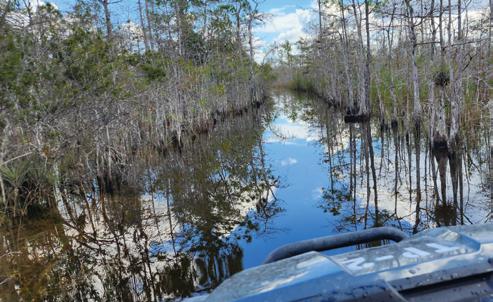
rangers, and stewards of the land, which will continue to be important as our environment, and world changes.
The boundary established in 1974 and the expansion of those boundaries in 1988, helped to protect the land within Big Cypress National Preserve from the threat of land drainage and urbanization. Today, changing ecosystems, saltwater intrusion and rising sea levels resulting from climate change are the threats the Preserve expects to face over the next 50-years. The Preserve and its partners continue to work together to find innovative and adaptive solutions to climate related threats, including the use of prescribed fires. Annually, wildland firefighters work to burn approximately 60,000 acres of prairie and pinelands to mimic the natural fire regime of southwest Florida in order to support ecosystem resilience. Additionally, the Army Corps of Engineers is working with the National Park Service and other
Comprehensive Everglades Restoration Plan (CERP) and Western Everglades Restoration Project (WERP). The partnerships and collaboration occurring between individuals and organizations who care about this unique environment are crucial to the mission of Big Cypress National Preserve and to our promise to protect this land for future generations.
The past 50-years of Big Cypress is a story of people enjoying and exploring the rugged and challenging landscape of the swamp. As we look forward to the future, and more specifically to the next 50 years, the story of Big Cypress remains one of people. People who have lived here, worked here, recreated here, volunteered here and so much more. Each person has played a significant role in the history of Big Cypress and while we can only imagine what will happen in the next 50 years, the one thing that is certain is that our story will remain rooted in people as we work to help protect this place for generations to come.
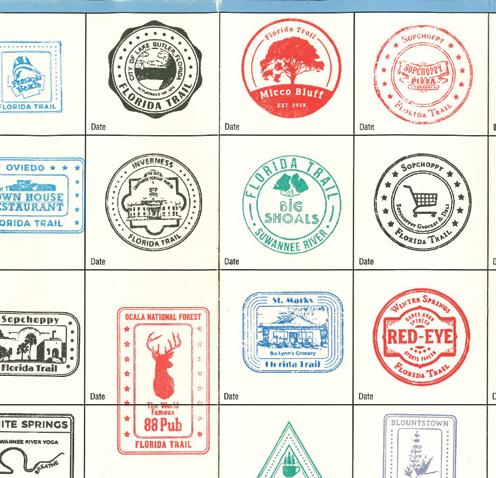
Introducing the Florida Trail Passport

VISIT OUR WEBSITE FOR DETAILS FLORIDATRAIL.ORG
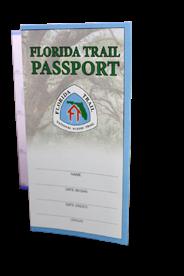
23 Spring 2024

24 FloridaTrail.org Florida Trail Association
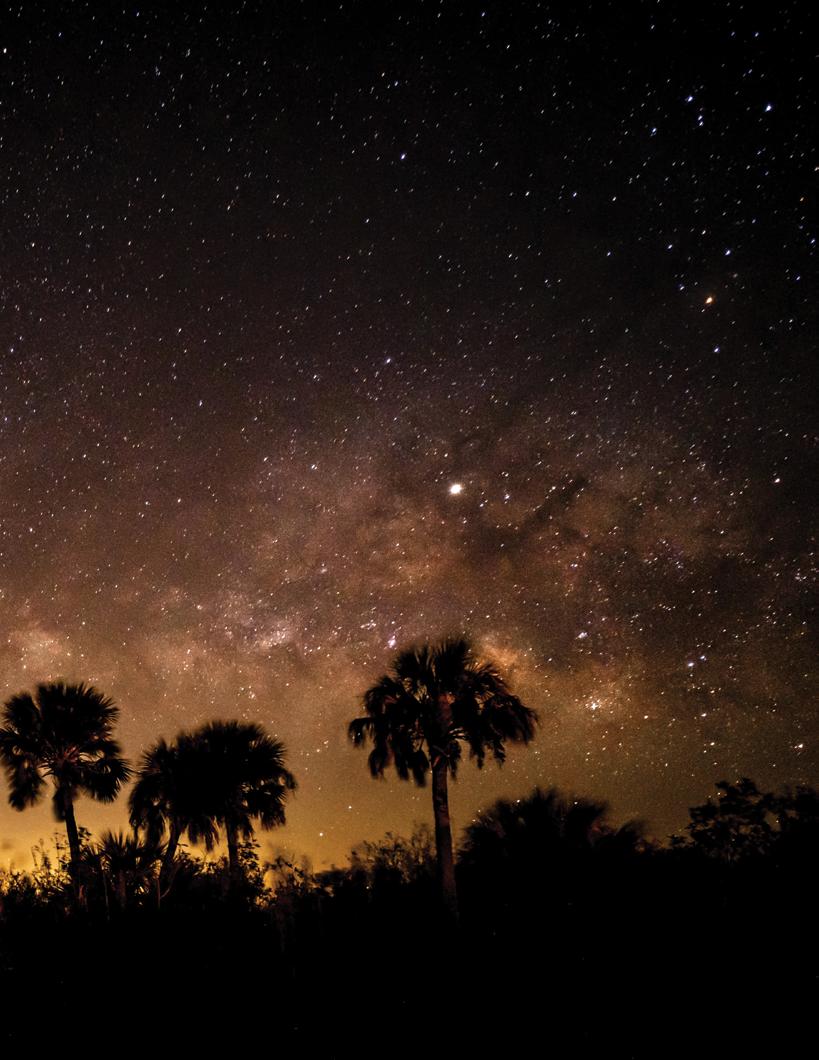
25 Footprint Spring 2024

Seminole Alligator Wrestling Danger, Entertainment and Tradition!
by James Patrick, Head of Exhibitions at the Ah-Tah-Thi-Ki Museum
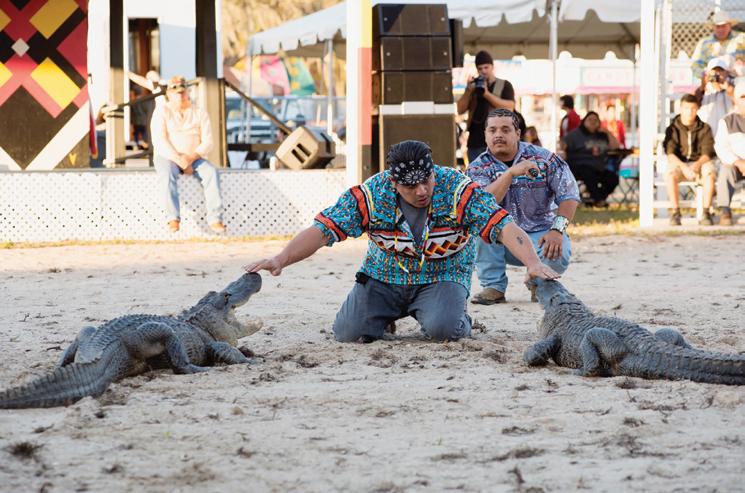

It’s Saturday at the Seminole Hard Rock Hotel and Convention Center in Hollywood Florida. The 2024 Tribal Fair and Pow Wow is taking place. It is a free annual Seminole Tribe of Florida family event that is open to the public. Tribal community members line the hallways as vendors, patrons, and participants to share in the abundance of activities. You can feel the excitement in the air. A large group of onlookers gather in the Seminole Ballroom, where that excitement elevates to an even higher level. Standing room only. AC/DC’s Thunderstruck begins pounding out of the loudspeakers, with all eyes on the center. The brave and talented showmen are about to exhibit their skills in the handling, interaction, and daring moves of what has become to be known as Alligator Wrestling.
The demonstration is a combination of a lesson in history, Seminole culture, and of course, daring maneuvers –captivating and entertaining the entire audience. The an-
26 FloridaTrail.org Florida Trail Association
Henry Coppinger Jr. at Pirate’s Cove, attributed to photographer Ralph R. Doubleday, circa 1930 ( ATTK Catalog No. 2013.3.243
).
James Holt doing double duty
Photos courtesy of Clint Holt
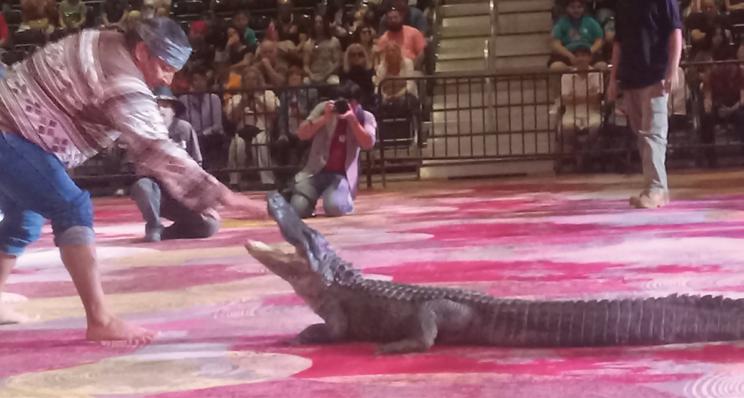
nouncer gives insight on why the wrestlers do what they do, and how they honor the people who came before. Between the audible “oohs” and “aahs” are lessons on life, delivered in unexpected ways. Remembering the past and honoring their struggle to create opportunity is relatable across many cultures.
For thousands of years, Seminoles hunted and captured alligators for food and hides. It is explained by historians that the Seminoles, who were masters of survival, used the animal to feed their people. The meat from the jaw and tail is loaded with vital nutrients. It is also pound for pound significantly richer in protein content than chicken, and twice as much as beef. There were no refrigerators, so alligators were tied, fenced or otherwise penned in, and kept alive to be harvested at a later time.
In the early 20th century, westerners became aware of Seminole alligator handling. Tourists and workers were intrigued by the Seminoles capture, tying, and dragging of alligators, and would offer money to watch them perform these acts. This helped the Seminole provide more for his family. Interest in the Seminoles increased at various locations that had Indian villages, including Musa Isle and Pirates Cove near Miami. Non-Seminole Henry (Sonny) Coppinger Jr. and his brothers FJ and Edmund popularized alligator handling with a showman’s flair. They recruited Seminoles and taught them other maneuvers to augment their performances. The Coppinger’s publicized the events by having “alligator
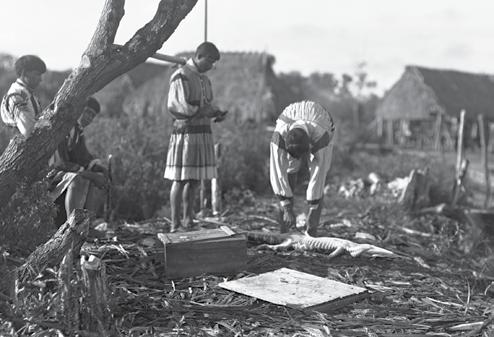
wrestling” featured in national magazines such as Collier’s and Saturday Evening Post.
In the 1940-1950s, there were other places where alligator wrestling could be seen regularly, like Tropical Hobbyland in Miami, and Aqua Glades in Fort Lauderdale. In the 1960s, Okalee Village was managed by the Seminole Tribe of Florida and sat on the reservation land where the iconic guitar
shaped hotel now sits…the very location of tonight’s show. A young Billy Walker watched alligator handlers like Richard Bowers, James Billie, and Thomas Storm Sr. In fact, Thomas Storm became the first mentor for Billy, who became a master alligator handler, practicing and demonstrating for several decades.
Before the show, the audience witnessed a tribute to James Holt who was
27 Footprint Spring 2024
Photos courtesy of James Patrick
Billy Walker reaches inside the jaws of an alligator at Tribal Fair performance.
Seminole man skinning an alligator, attributed to photographer Julian Dimock, circa 1910.
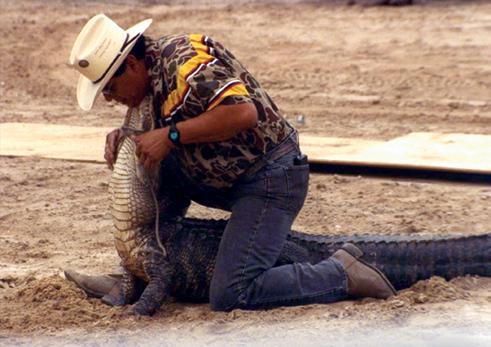
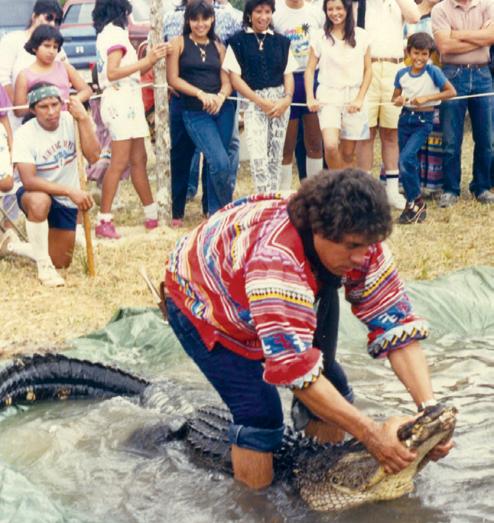
serving as President of the Seminole Tribe of Florida when he died unexpectedly last year. Holt was an alligator wrestler and pioneer in the development of the Freestyle Alligator Wrestling Competition (FWAC). This competition stretches the limits of daring showmanship with unexpected and dangerous maneuvers. Among the people sharing stories and showing respect are the two gentlemen who are about to give their presentations to the engaged audience: Billy Walker and Everett Osceola. One year ago, James Holt participated as the announcer for the show here at Tribal Fair. Being a skilled alligator wrestler himself, Holt explained to the crowd what was happening in real time with humor, respect, and historical context. Billy Walker is the featured performer tonight and dedicated the show to Mr. Holt. Everett, who had retired from alligator wrestling the year before at this very event, came out of retirement in honor of his close friend and mentor. This was a major highlight of the event.
Billy Walker has handled alligators since he was a young boy. Most, if not all the gators used in the presentations were captured by his own hands. The alligators Billy Walker uses today will be released back into the wild once the shows are over. He revealed that if he ever catches a gator with younglings, he tells those gators “I’m just gonna borrow your momma for a while and make her famous, I’ll bring her right back.” True to his word, he always reunites the family after the show, with the baby gators swimming up to greet the star performer from just hours before.
Typically, Billy does not have the opportunity to “know” the unpredictable alligator; they are freshly caught from the wild and do not come from a captive environment. He must read and assess how the animal will react and in what way he will go about interacting with that animal. Billy uses a medicine stick (sometimes referred to as “camp stick”) to assist in this task. Respect and honor run deep with Seminoles, and wrestling alligators is no exception. Permission is granted from the proper elders, gifts given, and blessings are bestowed upon the stick used to assist the handler. It is said that in the origins of alligator hunting, men used the poles from their canoe navigation to keep the gators at distance and evaluate their strategy for capture. Billy uses it to get the attention of the beast and solicit reactions which can tire out the animal and help him read how the gator will move.
The Seminoles are a resourceful people and in times of necessity, came up with ways that allowed them to be able to hunt alone. If going out in pairs, yields needed to be split, which caused conflict. Capturing
28 FloridaTrail.org Florida Trail Association
Richard Bowers at Brighton Field Days ( ATTK Catalog No. 2015.6.13415
).
James Billie wrestling a gator in a temporary pit ( ATTK Catalog No. 2015.6.17521
).

Thomas Storm Sr. ( ATTK Catalog No. 2015.6.15698 ).
an alligator alone has its advantages. However, controlling the gator requires the mouth to be secured and having both hands free to tie it shut. Although the bite force of an alligator is over three times that of a lion and second only to a crocodile, keeping the jaw shut can be accomplished with just a rope or piece of cloth. The Seminoles would mount the alligator and hold the mouth closed with their chins, freeing up both hands to tie and secure the jaws shut. This became an alligator wrestling move known as “bulldogging.” The moves that alligator wrestlers perform in their shows are determined by their style, preference, and practice of the daring entertainer. It has been said it is not if a wrestler is bitten, but when. So, every time they interact with an alligator, it is known that the slightest mistake or unanticipated movement could be devastating.
Over the years, some common names were attached to many of these maneuvers. Some of the names are the “Florida smile”, “face-off”, and the “Everglades kiss”. Various hand tricks startle the audience with a loud pop from the jaws narrowly missing the fearless performer. Billy Walker has performed in shows for well over 20 years. Great alligator wrestlers have signature moves, and Billy Walker has his own. One unique move of his is the “everglades jump rope”. This is where Walker leaps over the swinging tail several times, the tail that an alligator uses as a weapon to sweep the feet and knock over its prey.
With respect and honoring those from the past, some alligator handlers will duplicate feats made famous by others. An alligator wrestler from the 1940’s named Cowboy Billie used to perform a maneuver where he rolled on his back and pulled the gator on top of him. He did this without having the advantage of the alligator’s mouth tied. Incidentally, these moves are not tricks. They are thought out, they are practiced, and they are executed to perfection. However, one slip, one mistake, or any unexpected turn of events could end
Henry “Cowboy” Billie, attributed to photographer
Ralph R. Doubleday ( ATTK Catalog No. 2013.3.247 ).
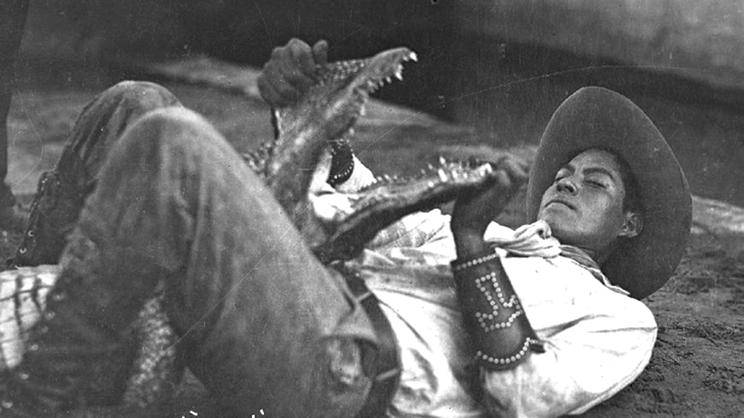
29 Footprint Spring 2024

Seminole Indian Wrestling Alligator Musa Isle Indian Village ( ATTK Catalog No. 2003.44.4 ).
up in tragedy. Tonight, Everett Osceola is honoring his friend and mentor James Holt by attempting to do the “Cowboy Billie” move. You can see the unwavering concentration on his face as he rolls that gator on top of him. Then, fearlessly, he displays to all, laying his hands stretched out on each side of him and the alligator. For final proof of this feat, he reaches up and pulls the alligator’s mouth open, displaying the creature’s 80 teeth and demonstrating handler’s courage, skill, and showmanship.
What the crowd might not realize is that the danger is far from over. Rolling the gator back is where real danger lies. As Everett rolls with the gator back on their stomachs, this fierce biting machine could do the unexpected. Several brave and ready spotters prepare to take action as circumstances dictate. Luckily, everything goes exactly as planned, the mouth is secured, and the audience roars with delight. The wrestlers are recognized by the MC, museum director Gordon O. Wareham. The alligator is taken by the spotters, crated, and made ready for transport back to the swamp. A combination of relief, joy, and elation is palpable all around. The audience is left with a wanting for more - a yearning for when they can see this again. Maybe there will be another chance to see this amazing performance at the next Seminole event!

30 FloridaTrail.org Florida Trail Association
Everett Osceola 2024 Tribal Fair
Photos courtesy of James Patrick
Save the Date IDIDAHIKE 2025
Hosted by the Sandhill Chapter - March 1st 2025
**Official registration opens in December**
PRE-REGISTRATION NOW floridatrail.org/ididahike
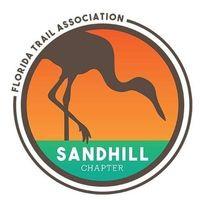
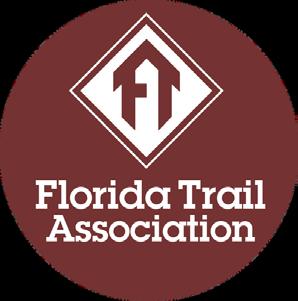

A few distances will be offered from the Land Bridge to Ross Prairie
31 Footprint Spring 2024

In the vast expanse of a cattle ranch, there exists a simple yet profound principle that echoes through the endless fields: leave the gate like you found it. This seemingly straightforward act embodies a powerful message of respect, not just for the land and livestock, but for the very essence of coexistence. When we close a gate behind us, we are not merely securing a passage; we are affirming our commitment to the delicate balance between human activity and the natural world. Each latch clicked into place is a testament to the understanding that we
are temporary stewards of this magnificent landscape. It speaks volumes about our responsibility to tread lightly, leaving no trace of our presence except for the echoes of consideration and reverence for those who will follow.
Sitting down in Gateway Community Business, Nutmeg’s Cafe, in Okeechobee with Brad Phares, the recurring theme of respect began to emerge. Phares, an 8th generation rancher living in Okeechobee, hosts a podcast called “Between the Beaches.” Aiming to talk about just that,
by Jenna Taylor, Regional Trail Manager Cattle Ranchers
Florida’s Original Conservationists
the things that happen in Florida in the communities in Florida that are not along our coastline, Phares has hosted over 150 episodes since beginning in 2020. More than that, Phares is a published author of “Celtic Cowhunter,” poet and artist.
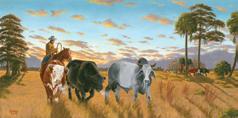
“Bringing in the bulls”
by Brad Phares
Phares and I talked about both the history of cattle and the future of the industry, what it means for Florida, and the conservation story that is weaved throughout. “Cattlemen have always been conservationists,” said Phares. “We have finally realized that our goals are not separate and distinct from other conservation groups. Ranchers are very private people, and a few generations back, they were so even more than now. It is culture and how they grew up. You focused on your work.” He believes, though, that as the generations have evolved, they are realizing that telling the story of the work they are doing in

Between the Beaches Podcast
Brad’s Playlist for hikers
Episode 127
“Grandaddy said we’d be here”
Episode 122
“Conservation candor”
Episode 96
“Processing Hyacinths”
Episode 88
“The Fight for Florida”
32 FloridaTrail.org Florida Trail Association

“Penning em at bull hammock”
by Brad Phares
the name of loving the land is not putting on airs, but an important conversation to contribute to. “This idea of conserving resources and being sustainable is not something new to us. We have been doing it, but we haven’t opened up about it. It has become apparent that we are all after the same thing and it is much better if we start working together,” shared Phares.
Cattle ranching in Florida has a deep-seated history, dating back to the 16th century when Spanish explorers introduced cattle to the region. The Spanish settlers, recognizing the favorable climate and abundant grazing lands, laid the foundation for a thriving ranching industry. As time progressed, Florida's unique environmental conditions, characterized by vast prairies and wetlands, prompted the emergence of the Cracker cattle breed. These hardy and adaptable cattle became a symbol of the state's ranching heritage, well-suited to navigate the challenges of

For an extensive history and incredible photos of the Florida Cowboy, check out Carlton Ward Jr.’s book.
down the state, it formed a foundation and the heritage for Florida,” said Phares.

“Most people don’t realize that cattle, cattle grazing, and herding culture is what forged Florida as we know it today,” said Phares. “The early cattlemen realized how much grazing land was down here and started the movement south.” Cattlemen realized years ago that cattle can be used to fertilize and aerate land which contributed to early homesteading. “Their practices regenerated the land over and over again, and as it spread
During the 19th century, cattle ranching in Florida experienced a significant boom. The extension of railroads facilitated the transportation of cattle to northern markets, opening up new economic opportunities for ranchers. The state became a crucial supplier of beef to the growing demand in the United States. Florida's ranching industry played a pivotal role in shaping the economic landscape and contributing to the frontier spirit of the region. Evidence of these early cattle ranches can be found all along the Florida Trail if you know what to look for. In KICCO WMA for example, sidewalks still stand where the original Kissimmee Cattle Company community was built in 1915. (For more on the KICCO history, check out the newly installed kiosks at the trailhead!)
In the contemporary era, Florida's cattle ranching industry has evolved with the adoption of modern technologies and sustainable practices. Ranchers continue to preserve the rich legacy of their forebears while embracing innovations that enhance efficiency and environmental stewardship. Today, Florida stands as a vital hub for cattle ranching, where the legacy of centuries-old traditions coexists harmoniously with the dynamic demands
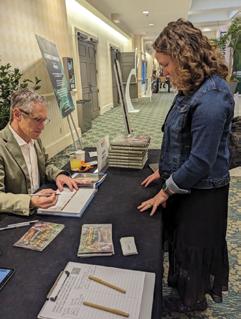
The author of this article, Jenna Taylor, getting her ‘Florida Cowboy’ book signed by Carlton Ward Jr. at the 2023 Florida Wildlife Corridor Conference where Florida ranching showcased their role in protecting the corridor.
33 Footprint Spring 2024
of the present, highlighting the enduring resilience and adaptability of the state's ranching community. Currently, the Florida Trail shares many lands with cattle leases on public lands and borders many ranches throughout the state. Over the years, the chapters have found the ranching community to be a quiet supporter and ally of the trail. In Okeechobee county, family ranches have allowed maintainers access to reach otherwise very challenging sections of trail to complete annual maintenance by crossing their lands. In other sections, hikers can give a polite nod to the curious cows that stare in confusion as they try to figure out where the hikers came from.
Cattle grazing is the least intensive land use you can have on a land, Phares believes. “Our state is growing at a blistering pace. We are going to have growth, there is no doubt about it. This unrestrained growth we have right now is not sustainable. If it was not for the green spaces that ranches provide, those working to facilitate the Florida Wildlife Corridor would not be able to stress the need to our legislators and be smarter about growth in Florida,” he maintains.
In Florida, the Florida Cattlemen’s Association is a statewide, non-profit organization devoted entirely to promoting and protecting the ability of cattlemen members to produce and market their products. According to Dusty Holly, Director of Field Services for the Association, the organization has a wide range of services that they provide to support cattlemen and cattlewomen throughout the state. “The Florida Cattlemen’s Association brings a unified voice to decision makers. Farmers and ranchers are busy every day taking care of the land. They don’t have time to be at every water management meeting and committee hearing. And if they did there would be 1,000 people trying to do the same thing,” said Holly, whose home ranch borders the Florida Trail on the western side of the state. “This unified voice is the deepest reason we exist.”
This year, the theme for the Florida Cattlemen’s Association is “Cows Keep Florida Green.” Holley believes that cattle ranchers do just that for the state. “The environmental sustainability of our state is important to our industry and the state as a whole. Cattle ranches are the excellent
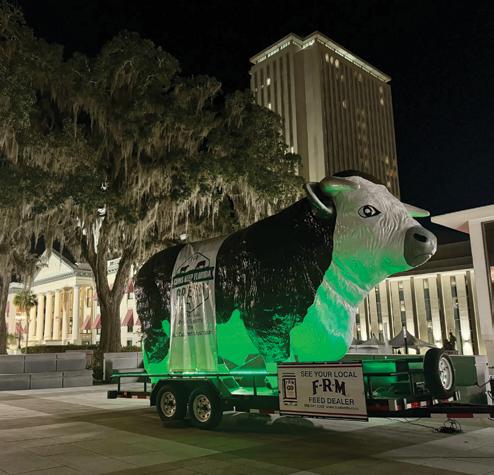
managers of the lands they use whether those are public or private,” says Holley. Through maintaining working lands, cattlemen can protect the lands and keep them in pristine condition.
“I think the biggest connection between hikers and ranchers is the desire to actively manage these lands. In a state like Florida, invasive species and underbrush can grow so fast and take over. That isn’t happening on lands being used for cattle,” said Holley. Anyone who has hiked through a sea of Caesar Weed, or had their viewshed impacted by wax myrtle or Brazilian Pepper can attest that these quick growing enemies of the trail can diminish from the beauty of the Florida Trail. “Where there are cattle leases on public lands, you see less of these things. There is more wildlife and birds,” Holley shared. “The state is doing the best they can to manage these lands, but resources are limited. A cattle rancher can do so much to support these efforts,” said Holley. “ At the end of the day, the cow is just a great land management tool.”
INTERSECTION OF ART AND COWBOYS
“I started realizing that the community really didn’t have any art,” says Bridgett Waldau who worked with the Okeechobee Main Street Arts and Cultural Alliance for 20 years until her recent departure in 2023. Okeechobee, a Florida Trail Gateway Community and hub for the Florida Cattle industry, sits about 150 miles into a Florida Trail thru-hiker’s northbound journey. A quaint mainstreet greets hikers, who are often ready for a zero day and a few hearty meals. In 2022 and 2023 though, a new art installation found its way into “Cattleman's Square.”
“I learned that in rural communities, art can be a hard sell. I knew whatever we did, needed to be about the community,” said Waldau. “I traveled to Leesburg and saw the cattle drive sculptures in the Villages and I wanted to bring that to Okeechobee.” Waldau and others started working on doing just that with artist J. Michael Wilson from Utah.
The first step in creating community buy-in was to raise the funds. Overall, half of the funds were raised by major donors and partners, but the other half came from community members themselves through private gifts and brick sponsorship. The county and city helped with the infrastructure and improved the grounds and crosswalks to ensure the public could access the sculptures.
Next came the design. “I got a nice lesson about cattle ranchers through this project,” Waldau said with a laugh. “I told the ranchers we wanted to celebrate their lifestyle
34 FloridaTrail.org Florida Trail Association
Cows Keep Florida Green at the Florida Capital during an FCA Legislative event in 2024. ”
Photo courtesy of Florida Cattlemen’s Association.
FLORIDA COUNTY ESITIMATES OF CATTLE 2022-2023
SEMINOLE TRIBE OF FLORIDA AS CATTLEMEN
Calves on Farms
January 1, 2023 Top Counties
Cattle Inventory
January 1, 2023
50,000 head or more
10,000 - 49,999
USDA/NASS Cooperating with the Florida Department of Agriculture and consumer services.
and they set the era in the 1950’s and 1960’s. We relied on their guidance, right down to the direction the cattle needed to be facing and how to display the dogs.” What was originally planned as four sculptures quickly became ten, including a cowboy riding a horse, a Brahma bull, 5 heads of cattle, a calf, a cow dog and a cowboy at a fence. Everything is designed to be moving to seem like a moment in time that has been captured. Informational kiosks are spread throughout the display
and tell the story of cattle ranching and the cowboys of the community.
“The magnitude of the sculpture needs to be seen in person. They are beautiful. The whole history of the cattle industry is in the park,” Waldau shared. “It pays homage to the history of Okeechobee. We hope that future generations will be proud of this. The massiveness of the sculptures need to be seen. As an artist, myself, I believe that it is a magnificent piece that tells a wonderful story.”

Waldau also encourages visitors to check out the mural on NE 2nd street by the CVS. It is the first installation the Alliance did and represents the Williams family cattle drive in 1927. Hanes Williams, the boy on the pony in the mural remembered this drive and provided guidance. The piece was done by local middle and high school students along with the artists.
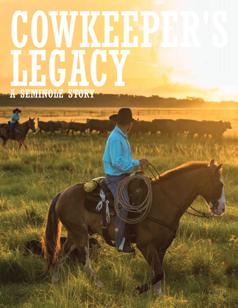
The Seminole Tribe of Florida has been raising cattle for generations. The Tribal Historic Preservation Office of the Seminole Tribe of Florida recently published
“ Cowkeeper’s Legacy: A Seminole Story ,” available at www.stofthpo.com
This comprehensive document opens with poetry by Moses Jumper Jr. of the Snake Clan and covers the extensive history of cattle ranching and introduces readers to cowboys in the Seminole Tribe of Florida community.
CATTLE (AND PEOPLE) NEED WILD OPEN SPACES
I asked Brad what he believed hikers needed to understand about the cattle community and what we can do next. His response was simply to remember: “We all want the same thing, to preserve the wild open space. We are on the same team.”
“Florida can be a tropical paradise but if we’re being honest, it's a swamp. It has always been a swamp. Instead of fighting against it, we need to work with. If that means, maybe we don’t build so much, then that's what we need to do.” said Phares. He believes the hiking community can learn about the state’s ecology and carry that message back to others. “Users on the trail can experience what is in the middle of the state, away from the coast, and understand the importance of it for the future. They can then go back into
35 Footprint Spring 2024 Phone: (800) 253-4419 www.nass.usda.gov Cooperating with Florida Department of Agriculture and Consumer Services Cattle 2022-2023 Released: May 2023 State Statistician: Mark Hudson *Counties not published due to insufficient data or to avoid disclosure of individual operations. USDA/NASS COOPERATING WITH THE FLORIDA DEPARTMENT OF AGRICULTURE AND CONSUMER SERVICES POLK COLLIER LEE LAKE PALM BEACH MIAMI-DADE OSCEOLA HENDRY BREVARD GLADES BROWARD ORANGE PASCO MONROE HIGHLANDS MARTIN MANATEE CITRUS HARDEE DESOTO SUMTER HILLSBOROUGH ST. LUCIE OKEECHOBEE CHARLOTTE SARASOTA HERNANDO INDIAN RIVER SEMINOLE BAY LEVY MARION VOLUSIA WALTON DIXIE TAYLOR DUVAL LEON CLAY GULF ALACHUA LIBERTY JACKSON PUTNAM SANTA ROSA OKALOOSA BAKER NASSAU MADISON COLUMBIA ESCAMBIA WAKULLA ST. JOHNS SUWANNEE CALHOUN HOLMES FLAGLER FRANKLIN GADSDEN JEFFERSON HAMILTON LAFAYETTE WASHINGTON UNION PINELLAS GILCHRIST BRADFORD MONROE MIAMI-DADE LEE FRANKLIN
head 1,000 - 9,999 head Less than 1,000 head or Not Published* Okeechobee165,000 head Highlands115,000 head Osceola 93,000 head Polk 88,000 head Hardee 67,000 head State Total1,620,000 head Cattle and
Graphic courtesy of USDA/NASS.
Photos courtesy of Okeechobee Arts and Culture Alliance and Sharon Jones, photographer.
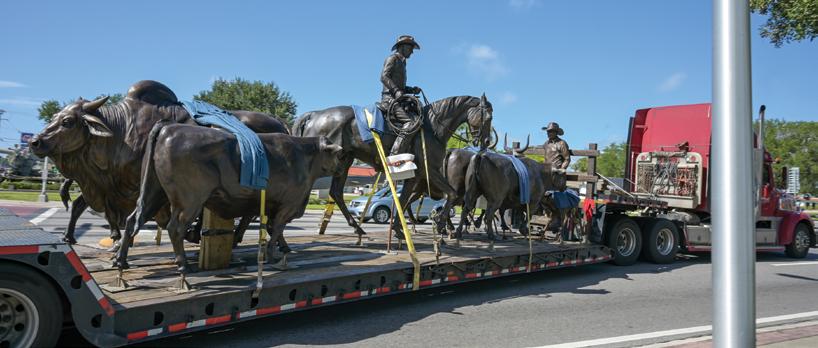
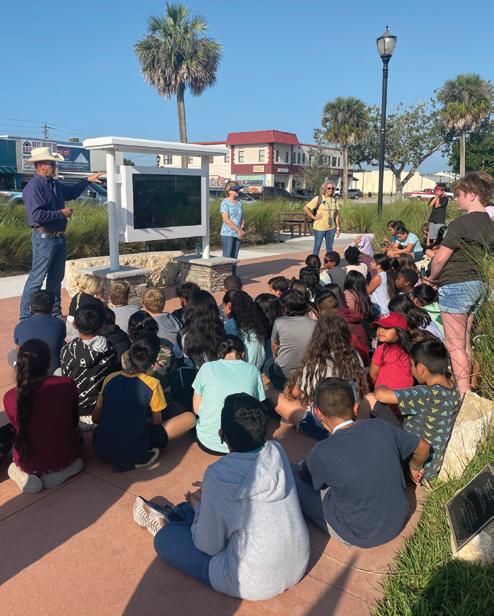
those urban areas and share what they have seen and raise the importance of open space,” Phares said.
He and the Florida Cattlemen's Association also believe that one of the simplest things we, as a hiking community can begin to do to support our local ranchers and farmers is to buy local. According to Fresh From Florida, Florida farmers, fisherman and ranchers have a $132 billion dollar impact across the state and provide over two million jobs. Knowing where your food comes from creates a sense of community and keeps dollars local. Local dollars for the ranch ensures that lands stay protected and green. A list of local beef providers can be found on the Florida Cattlemen's Association website (www.floridacattlemen.org) and on a variety of other sources as well.
“I believe that people who are into hiking are often into a healthy lifestyle. Beef is a wonderful protein source and supports the land,” Phares shared. He believes this is a continued connection between hikers and the relationship cattlemen have with the land.
Agrotourism, including things like corn mazes, farm tours, hay rides and more are easily accessible throughout the state. Fresh From Florida has an easy to use app that will show you things near you or even better, near the Florida Trail section you plan to explore next!
A COWHUNTER’S MUSINGS ABOUT FLORIDA’S FUTURE
In addition to being an outstanding artist, Brad Phares is also a poet. On his website, you can find a reading of his poem “Crooked and Clear,” about the Kissimmee River from his book “The Celtic Cowhunter”. He wrote about his family and their life in early Florida:
36 FloridaTrail.org Florida Trail Association
Local students learning about cattlemen history through art.
Photos courtesy of Okeechobee Arts and Culture Alliance and Sharon Jones, photographer.
The sculptures being delivered.
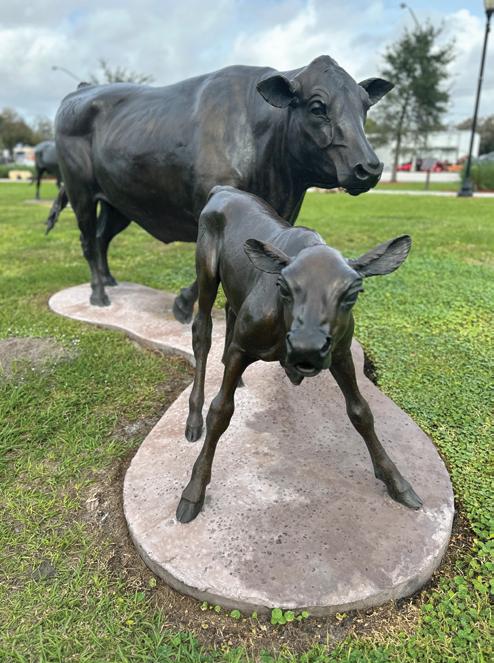
“Their cattle grazed on the prairie wherever they chose, but change was looming on the horizon as the 19th century came to a close. Florida had been wild and untamed where cattle were plenty and folks were few……
Hailed as a tropical paradise, people came funneling down here in droves, all of them chasing waterfront sunshine, shoving aside old Florida, her ranches and groves….
Today cattle are few and people are many as they pour concrete for that final crop. As always it seems we are losing the battle watching our grasslands give way to rooftops…
I gaze out across these same old waters… knowing once again, she will never again run crooked and clear.”
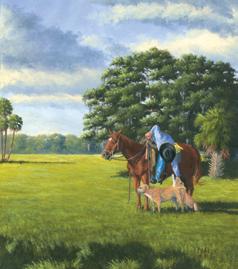
“Job well done” by Brad Phares
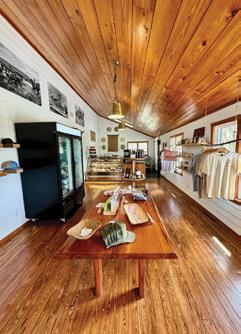
Adams Ranch, Inc. in Fort Pierce, FL is a fourth generation cattle farm in Florida encompassing nearly 40,000 acres. They opened a Farm Store in 2023 selling their beef and other local products and meats. When asked, Amanda Adams-Purnell said “Serving local communities by providing beef from our own Adam’s Ranch cattle was a dream of my grandfather, Bud Adams, that we are blessed to continue today. Adams Ranch Natural Beef is Fresh From Florida from ranch to plate and we are so thankful for everyone who supports our local business.”
www.adamsranch.com .
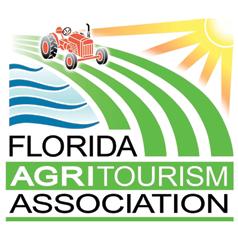

Fresh From Florida Agritourism App is free from the Apple App store and Google Play.
37 Footprint Spring 2024
Photos courtesy of Okeechobee Arts and Culture Alliance and Sharon Jones, photographer.
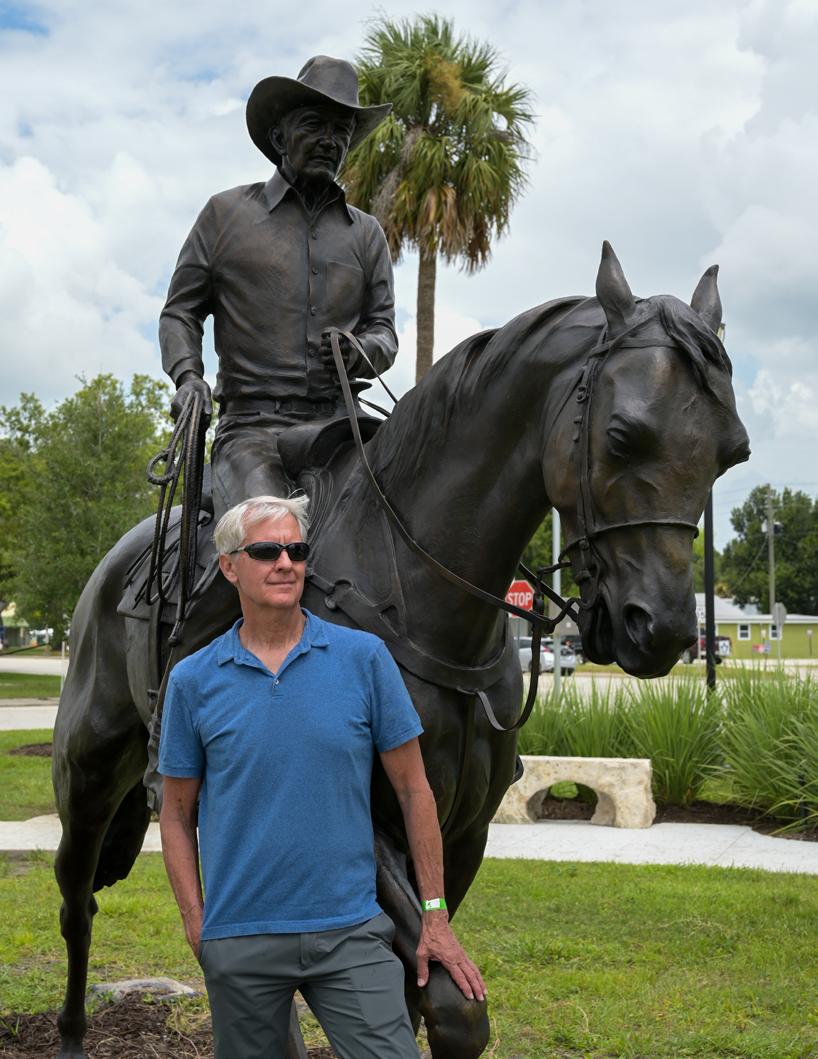 Artist J. Michael Wilson.
Florida Trail Association
Artist J. Michael Wilson.
Florida Trail Association
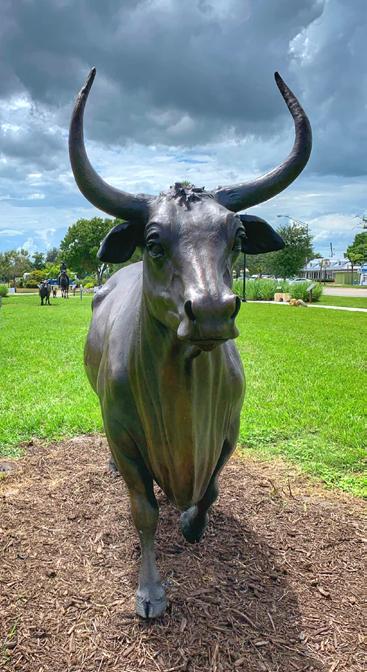
SCULPTURES
BY ARTIST J. MICHAEL WILSON


39 Footprint Spring 2024
Photos courtesy of Okeechobee Arts and Culture Alliance and Sharon Jones, photographer.
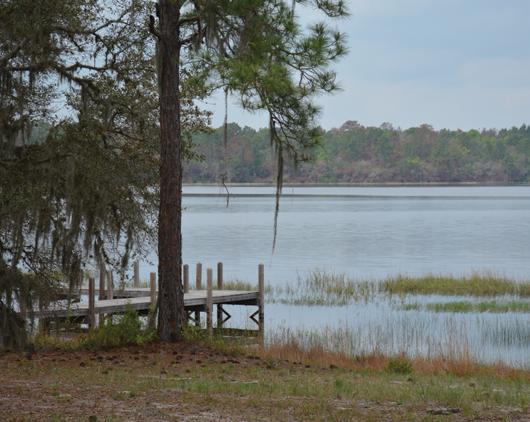
The Legacy of Segregation Echoes Through Florida’s Landscapes
by Jeff Glenn and Jane Pollack, Florida Trail Association Staff
park featuring 3,000 feet of lake frontage, a boat ramp, a dock, a swimming area, a bath house, and picnic pavilions. Amateur historian Robert E. Dews uncovered reports of the Florida Board of Parks and Historic Memorials before desegregation referencing the Magnolia Lake facility including the following description:
"Reserved for our Colored patrons, this Park provides picnic facilities, rudimentary sanitary facilities, a water system, a boat dock and boat launching ramp. To further open this Park to the public we still need a complete water system, ranger residence, combination building, additional picnic facilities, entrance and gatehouse, equipment shelter and shop and several other items."
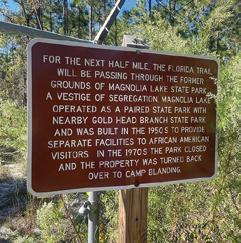
For many, state parks evoke images of serene natural landscapes, offering a retreat from the hustle and bustle of urban life. However, behind the tranquility lies a complex history marred by segregation, particularly in the South. While the topic of racism is rarely discussed in the context of outdoor recreation, and certainly not something that comes up often along the Florida Trail, it is a topic worthy of discussion given its profound impact. The legacy of segregation in these outdoor spaces is a sobering reminder of the systemic racism that once permeated every aspect of society. In the Jim Crow era, state parks in the South were not immune to the discriminatory practices of the time.
In Clay County near the town of Keystone Heights, a segment of the Florida
Trail offers a glimpse into the state’s regrettable past, when recreational opportunities were delineated by the color of one’s skin rather than being inclusive spaces for all. Instead of serving as havens for all citizens to enjoy nature, many parks were divided along racial lines, with "whites-only" and "colored" facilities. In the years surrounding the 1954 Brown v. Board of Education decision, state and county governments in the South built "colored" schools and public facilities, using the “separate but equal” doctrine to create the illusion of equality. Despite efforts by white officials to simulate equality, segregation perpetuated. Outdoor spaces were no exception. African Americans were often relegated to inferior and overcrowded areas with limited amenities. Throughout the South, this segregation extended beyond park boundaries, impacting every aspect of recreational life, from swimming pools to picnic areas, from hiking trails to campground facilities.
In the heart of the sandhills, lakes, and scrub habitat of northeast Florida, most people are very familiar with the well loved Mike Roess Gold Head Branch State Park. It is a gem in the State Park system here in Florida, and a place that most Florida Trail hikers look forward to. Often unknown, and rarely talked about, is the very nearby former Magnolia Lake State Park, now part of Camp Blanding Joint Training Center.
Proposed in 1955 as a counterpart to the whites only Gold Head, Magnolia Lake was constructed in 1957 for African American residents of Clay County, with the 191-acre
The description suggests that the park, while likely an enjoyable place to recreate, lacked many amenities available at the parks designated for whites only. Magnolia Lake State Park was one of about a half-dozen segregated state parks for African Americans in Florida, including Little Talbot Island, Frank B. Butler beach, and Tomoka State Parks. Magnolia Lake was a popular recreation spot for much of Clay County's African American population to gather and relax, one of the hallmarks of the outdoors that many of us cherish. Across the state, scenic beaches and parks offered reprieve from the daily experience of oppression and racism. However, African Americans were barred from many premier green spaces, and wanted to visit them freely like their white counterparts. The National Parks Service had an official nondiscrimination policy, but the state parks did not. Due to the blatant inequality of the state parks, the NAACP dubbed them the “Achilles’ Heel” of the Jim Crow system.
Civil rights activists, including lawyers and community organizers, challenged segregation in state parks through legal battles and grassroots movements. Following several lawsuits, protests, and pressure from the federal government, Florida State parks became fully integrated in 1964 with the passage of the Civil Rights Act, which prohibited segregation in public facilities, including state parks, on the basis of race, color, religion, or national origin. Magnolia Lake State Park eventually closed in the 1970s, and management of the property was returned to Camp Blanding.
40 FloridaTrail.org Florida Trail Association
Photo courtesy of Chris Stevens.
Photo courtesy of Sandra Friend.s.
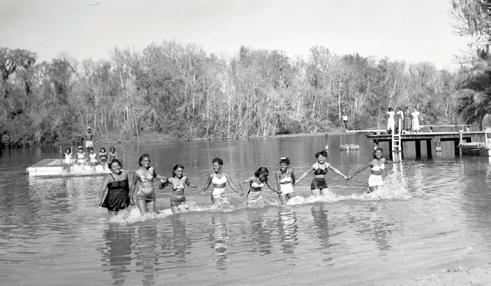

Crowds gather at the edge of the white sandy banks of the Silver River watching the children swim at Paradise Park, a privately owned attraction for African Americans only. Owners of the Silver Springs attraction Carl Ray and W.M. "Shorty" Davidson opened Paradise Park in 1949. The park was located just south of Silver Springs and stayed in operation until the late 1960s.
EXPLORING MAGNOLIA LAKE ALONG THE FLORIDA TRAIL
The closure of the Florida Trail on the Keystone Airpark in 2013 forced a reroute that established a new route through Camp Blanding and into the former Magnolia Lake State Park. The vast majority of trail users would otherwise never have had the opportunity to pass through and learn about this seemingly forgotten place. From here the abandoned park infrastructure comes
into plain view. These vintage structures are of similar styles found in nearby state parks like Paynes Prairie in Gainesville. Bathouses, mosquito research shacks, pavilions, picnic tables, and grills are all still here, albeit with living roofs at this point.
Aside from the relics of Magnolia Lake State Park's past, the scenery here is beautiful, with unobstructed views of Magnolia Lake and a combination of towering pines and majestic live oaks. There are not many lakes
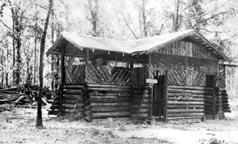
Segregated bathhouse at O’Leno State Park. O'Leno State Park was built by the Civilian Conservation Corps under direction of the U.S. Forest Service and the Florida Forest Service between 1935 and 1942. The park began as a Florida Forest Service training facility until 1941, when it became a state park. Note: separate facilities for "White" and "Colored".
Information about the history of Magnolia Lake State Park is surprisingly sparse. For those interested in learning more about Florida’s history of segregation in the outdoors, several books and resources are available.
Landscapes of Exclusion State Parks and Jim Crow in the American South by William E. O'Brien
Remembering Paradise Park Tourism and Segregation at Silver Springs by Lu Vickers and Cynthia Wilson-Graham
Paradise Lost
Florida’s Segregated Beaches and Parks Video from the Florida Channel (28 mins.)
https://thefloridachannel.org/videos/ paradise-lost-floridas-segregatedbeaches-parks/
41 Footprint Spring 2024
Photo courtesy of State Archives of Florida.
Photo courtesy of State Archives of Florida/Mozert.
Photo courtesy of State Archives of Florida/Mozert.
Young women having fun at Paradise Park.
along the Florida Trail with this much unfettered lake frontage.
The easiest way to explore this section of trail is to park at the Treat Rd Trailhead and hike in for approximately one mile before coming to the shores of Magnolia Lake.
To make this part of a larger hike, enter Camp Blanding at its northern access point along SR 21 and hike approximately 4.5 miles to reach Magnolia Lake State Park. With two cars, an easy shuttle can be made by parking a car at the Treat Rd. Trailhead and the northern trailhead on SR 21 to make this a 5.75 mile hike.
While the history of Magnolia Lake State Park is unpleasant and shameful, it should not be forgotten. Having the Florida Trail travel right through the former park grounds is an opportunity for the public to learn about the uncomfortable past as a means to move forward in a more positive direction. Similarly, Florida State Parks preserve landmarks and sites of importance in Florida’s black history, providing opportunities for both education and introspection. As we reflect on the history of segregation in state parks, it is essential to acknowledge the resilience of those who fought against injustice and to recognize that the fight for equality in outdoor spaces is an ongoing journey. By understanding this history, we can work towards creating truly inclusive outdoor environments where everyone, regardless of race or background, can experience the beauty of nature without fear or discrimination.

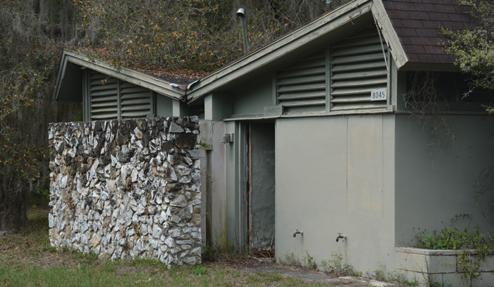
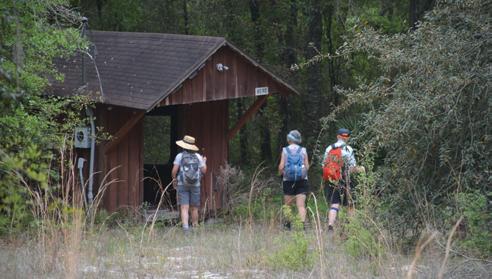
Florida State Parks Today
Several Florida State Parks showcase the impactful contributions of African Amerians to Florida’s History and Culture.
Civil War Battle of Olustee: At this battle, two regiments of black Union Army troops played a crucial role, preventing further casualties during the conflict. The Battle of Olustee is commemorated at Olustee Battlefield Historic State Park with reenactments, living history interpreters, and various activities.
The Network to Freedom: Fort Mose Historic State Park in St. Augustine and Bill Baggs Cape Florida State Park are designated National Underground Railroad Network to Freedom sites, historical stopovers of people escaping slavery.
The Great Depression and Florida's First State Parks: The Civilian Conservation Corps (CCC) played a significant role in building Florida's first state parks during the Great Depression, with an African American CCC corps contributing to projects such as Myakka River State Park.
A Unique Community: Alfred B. Maclay Gardens State Park in Tallahassee has a unique history, with a landowning African American community established near the park after the Civil War. Check their website for educational hikes led by park rangers.
Fighting for Recreation Rights in the 1960s: Dr. Von D. Mizell-Eula Johnson State Park near Fort Lauderdale is named after civil rights activists who fought for African American access to county beach facilities. This struggle for civil rights also led to the integration of parks like Maclay Gardens State Park.
42 FloridaTrail.org Florida Trail Association
Photo courtesy of Sandra Friend.
Photo courtesy of Sandra Friend.
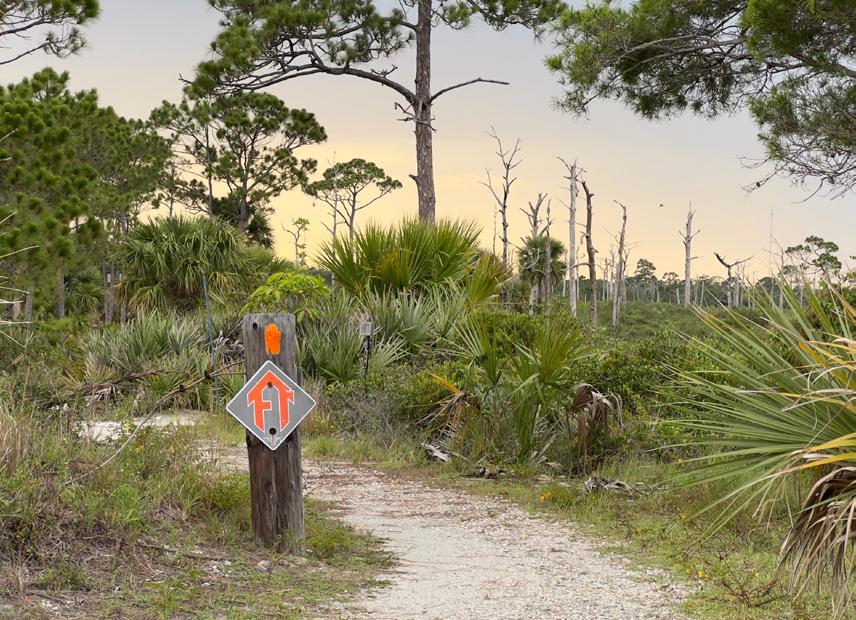


43 Footprint Spring 2024
YOU LOVE LIVE WILDLY.
IF YOU LOVE EXPLORING THE TRAIL Connecting people to nature to keep Florida, Florida FOLLOW US!
THEN
FLORIDA

Native American
by Catherine Selin, Panhandle Trail Program Manager
Preserving the Byrd Hammock Archeological Site
The Florida Trail is well known for its unique natural environments and subtropical scenery. No other National Scenic Trail offers anything like it; hikers encounter cypress domes and mossdraped live oaks, rolling wiregrass savannah and pine flatwoods, dark swamps and emerald gulf waters. Hiking along the FT, it's easy to imagine that you’re exploring a landscape untouched by people, and a key part of our mission is protecting these places from further human development. But the idea of a primitive Florida, a wilderness without people, is a myth. For thousands of years before European colonization, the Native people of Florida lived in these environments. They built their homes and villages, hunted and fished, and practiced their religions. While the history of these civilizations can be difficult to trace—we have no written record or oral history to rely on—the archaeological record can be surprisingly illuminating. A key to understanding this history has been the excavation of Native American villages. One area in particular—the Byrd Hammock site near Wakulla Beach in the St. Marks National Wildlife Refuge—has emerged as an important place along the Florida Trail to highlight this history.
The Byrd Hammock site has its origins between approximately 450 C.E. and 650 C.E and was occupied for over 1,500 years. Despite the incredible amount of change that has occurred over a millennium and a half, Byrd Hammock remains an important archaeological site that has the potential to contribute to our understanding of the past. The site was occupied by two distinct but subsequent phases of occupation. These two consecutive cultural periods represented at the site, Swift Creek and Weeden Island, occur in distinct physical spaces, each with its own paired set of features: a ring midden and a shell mound. A ring midden is the accumulated debris left behind by human activity typically consisting of shells, bones, and pottery. Shell mounds also accrued debris however they may have
been used for burials and ceremonial purposes.
Over the course of the time, after a village was abandoned and its structures had decomposed, the midden rings and burial mound would remain. Slowly being covered by vegetation and soil and weathered by wind and rain, the history of this site and its people were not entirely lost.
From an onlooker's perspective today, the Byrd Hammock site appears as a series of low scattered humps of earth within a hardwood hammock. On an otherwise flat forest floor, these mounds offer the first clues that this landscape has been impacted by human activity. Looking closer, one can see other signs: rich, dark soil stands out from the surrounding white sand, a sign of decomposed organic material. Within the soil are accumulated bits of shell, bones, and pottery fragments. These fragments provide hints about what the lives of these people were like; what they ate, the tools they used, even their religious and cultural practices.
By examining the artifacts found within the Byrd Hammock mounds and other sites throughout the Southeast, archaeologists have concluded that they actually belonged to two separate cultural groups, the Swift Creek People and the Weeden Island People. One seems to have superseded the other, although for a time the villages existed sideby-side. The Swift Creek people came first; their pottery features a prominent stamped pattern created by repeatedly pressing a carved wooden paddle into wet clay. In contrast, the Weeden Island people would directly inscribe their pottery, creating more intricate designs. The burial mounds of the Weeden Island people also suggest a change in religious practices. Their mounds have a solar alignment; a person standing within the plaza of a Weeden Island village would see the sun set directly over the mound on the winter solstice. While there’s much we don’t know, these clues hint at social changes within these communities, as one village was abandoned
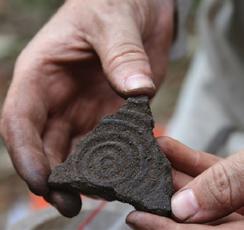
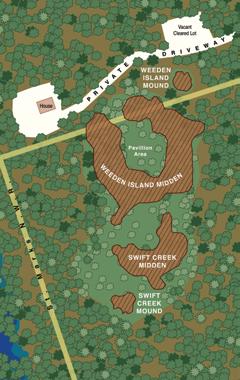
44 FloridaTrail.org Florida Trail Association
History Along the Florida Trail
Potsherd from the Byrd Hammock site. Photos courtesy of National Park Service
Layout of the Byrd Hammock Archaeological Site.
and new cultural practices emerged.
The Byrd Hammock site was first excavated in 1918 by an explorer named Clarence B. Moore. Moore traveled throughout the southeast on a mission to document and excavate prehistoric Native American villages; he correctly theorized that many of the structures he found were burial mounds. Archaeologists built upon his work in the 40s and 50s, making discoveries about the middens and their significance. Unfortunately, these early excavations also helped to popularize the location of these sites to people less interested in academic discovery and more invested in making a profit. Over the last hundred years, looters and pothunters have repeatedly pillaged the site, searching for burial pottery and stone tools such as arrowheads. Without protection by state or federal authorities, the site was wide open for exploitation.
To safeguard the future of the Byrd Hammock mounds, the FTA has partnered with the U.S. Forest Service, the St. Marks National Wildlife Refuge, and the U.S. National Park Service's Southeast Archeological Center (SEAC) to develop a plan to protect and share this site with the public. This is an exciting development for the Florida Trail; in St. Marks alone, there are four prehistoric village sites directly along the FT, none of which have been opened for public interpretation. Like any large conservation effort, the project has taken many years and the combined efforts of many partner groups. In

2013, SEAC first began working with county officials and local partners to acquire the land containing the Byrd Hammock site. The land was ultimately purchased and then donated to the U.S. Fish and Wildlife Service to become part of the St. Marks Refuge.
As a first step in developing this site for interpretation, the FTA was awarded a grant from the State of Florida’s Division of Historical Resources to coordinate the creation of an interpretive website about the Byrd Hammock site. SEAC collaborated with the Florida Center for Interactive Media to create the website; this portion of the project was recently published and can be viewed at byrdhammock.floridatrail.org. SEAC also created 3-D scans of many artifacts recovered from the site, along with a virtual reality artifact explorer program to allow users to interact with the models. Owners of a VR headset can download this software from the Byrd Hammock website, and the FTA will be showcasing a VR headset with this software at future outreach and tabling events.
Of course, these digital resources are only the first step in a larger plan to open this historical site for public access. Our next step will be working with the St. Marks Refuge to build a short spur trail that will connect the Florida Trail to the village site. NPS archeologists will help us to prepare the site, both to ensure future protection of the resource and to maximize visibility of the mounds and middens. Some of the trees and undergrowth
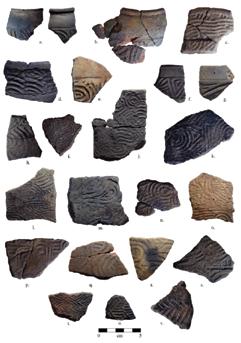
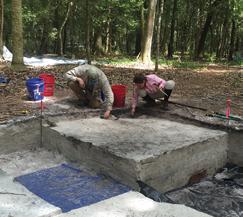
from the plaza sites will be cleared, allowing visitors to imagine the scale of the vanished settlements. We'll also work to create signage, kiosks, and other interpretive tools to help tell the story of the people who lived here. Once all of the improvements are complete, the FTA is looking forward to collaborating with SEAC and the St. Marks Refuge on school programs and educational trips to the site. With its close proximity to the Wakulla Beach Trailhead, we anticipate that Byrd Hammock will become a popular landmark along this section of the Florida Trail.
Stay tuned to our newsletter for further developments!
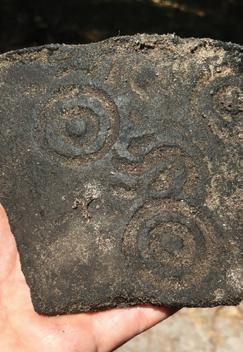
45 Footprint Spring 2024
Stone tools recovered from Byrd Hammock
Examples of Swift Creek Pottery
SEAC Exacations of the Byrd Hammock Site
Close View of some Byrd Hammock Pottery
FTA Chapters

ALLIGATOR AMBLERS CHAPTER
Charlotte, Collier, and Lee
Carl Kepford 239-253-4255
APALACHEE CHAPTER
Franklin, Gadsden, Jefferson, Leon, Liberty, and Wakulla
Shellie Johnson 239-898-0125
BIG CYPRESS CHAPTER
Miami-Dade and Monroe
Susan Bennett-Manns 305-213-1500
BLACK BEAR CHAPTER
Flagler, Putnam, and Volusia
Ed Riskosky 315-374-6500
CENTRAL FLORIDA CHAPTER
Orange, Seminole, and Osceola
Bill Turman 407-413-2950
CHOCTAWHATCHEE CHAPTER
Walton and Okaloosa
James Wilson 281-543-4802
FISHEATING CREEK CHAPTER
Hendry and Glades
Margaret England 863-517-0202
HAPPY HOOFERS CHAPTER
Broward
Lynn Thompson 954-372-7480
HEARTLAND CHAPTER
DeSoto, Hardee, Highlands, and Polk
David Waldrop 863-605-3587
HIGHLANDERS CHAPTER
Lake and Sumter
Gene Bouley 352-360-3722
INDIAN RIVER CHAPTER
Brevard and Indian River
Bill Alexander 321-693-7369
LOXAHATCHEE CHAPTER
Palm Beach
Janet Miller 561-385-8676
NORTH FL TRAILBLAZERS CHAPTER
Baker, Bradford, Clay, Duval, Nassau, St. Johns, and Union
Ron Fish 904-504-4359
PANHANDLE CHAPTER
Bay, Calhoun, Gulf, Holmes, Jackson, and Washington
Ken Doucette 772-485-1923
When you join the state-wide Florida Trail Association you automatically become a member of your local chapter based upon your zip code. However, members may attend the activities of any chapter and may transfer to any chapter they wish simply by informing the FTA Office.
Florida Trail activities are organized by our local chapters and are led by authorized volunteer activity leaders. Many of our activities are open to the general public so you can get to know us before you join. Activities can be found online at floridatrail.org. Click on "Get Involved" then click on "Find Your Local Chapter." From there, check out the map to determine your local chapter. Activities are usually posted on the chapter websites, Facebook pages, and Meetups.
Participants in activities must sign an Assumption of Risk form and agree to accept personal responsibility for their safety and the safety of accompanying minors. Always contact the activity leader in advance for more information, to let them know you are attending, to find out any special requirements or equipment for the activity, and to check for any last minute changes.

SANDHILL CHAPTER
Alachua, Levy, Gilcrist, and Marion
352-378-8823
Rick Robbins 352-445-0201
SUNCOAST CHAPTER
Citrus, Hernando, Hillsborough, Manatee, Pasco, Pinellas and Sarasota
Sue Bunge 727-504-8574
SUWANNEE CHAPTER
Columbia, Dixie, Hamilton, Lafayette, Madison, Suwannee, and Taylor
Vacant
TROPICAL TREKKERS CHAPTER
Martin, Okeechobee, and St. Lucie
Tom Clements 772-486-2816
WESTERN GATE CHAPTER
Escambia and Santa Rosa
Christine Hale 850-723-5112
46 FloridaTrail.org Florida Trail Association


47 Footprint Spring 2024
FORM
MEMBERSHIP MY GIFT TO THE TRAIL MEMBERSHIP AND GIFT
Photo by Todd Kelly
JOIN BY PHONE 877-HIKE-FLA OR ONLINE AT floridatrail.org/join Name Spouse Phone Address City State Zip Email
to: Name Address City State Zip Phone Email Ship membership package to Me New Member The Footprint magazine? Digital Printed Please mark
are joining
renewing your membership in the Florida Trail Association $35 $50 $100 $500 $1000 Other $35 $50 $100 $500 $1000 Other SEND FORM AND PAYMENT TO: FLORIDA TRAIL ASSOCIATION 1022 NW 2nd Street, Gainesville, FL 32601. My gift is:
Memory In Honor Of PAYMENT OPTIONS: CHECK: Make checks payable to “Florida Trail Association”. CREDIT CARD: Number: Exp. Date: Signature: CVV (3 or 4 digits):
Photo by Van Tran
I do not want my address shared with FTA-affiliated organizations Please send a gift membership
one of the boxes below if you
or
In
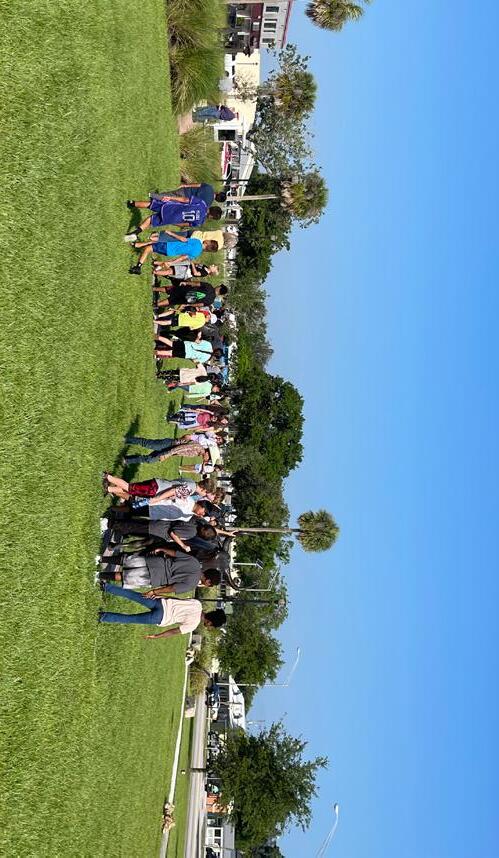

48 FloridaTrail.org Florida Trail Association FLORIDA TRAIL ASSOCIATION 1022 NW 2nd Street Gainesville, FL 32601 NON-PROFIT ORG PRSRT STD U S Postage PAID Pontiac, IL Permit No. 592 Donate to The Florida Trail Association Visit our website online FloridaTrail.org Kids group field trip to Cattleman's Square in Okeechobee.









































 Pitcher plants are often found in the scenic Yellow River Ravine wetlands.
Pitcher plants are often found in the scenic Yellow River Ravine wetlands.



























































 Artist J. Michael Wilson.
Florida Trail Association
Artist J. Michael Wilson.
Florida Trail Association


























